
About UsThe Numismatic Bibliomania Society is a non-profit organization devoted to the study and enjoyment of numismatic literature. For more information please see our web site at coinbooks.org SubscriptionsThose wishing to become new E-Sylum subscribers (or wishing to Unsubscribe) can go to the following web page link MembershipThere is a membership application available on the web site Membership Application To join, print the application and return it with your check to the address printed on the application. Membership is only $20 to addresses in the U.S., $25 for First Class mail, and $30 elsewhere. For those without web access, write to: Terry White, Treasurer
AsylumFor Asylum mailing address changes and other membership questions, contact Terry at this email address: terrywhite5475@yahoo.com SubmissionsTo submit items for publication in The E-Sylum, just Reply to this message, or write to the Editor at this address: whomren@gmail.com BUY THE BOOK BEFORE THE COINSale Calendar |
- WAYNE'S WORDS: THE E-SYLUM OCTOBER 4, 2015
- ASYLUM APRIL-JUNE 2015 ISSUE PUBLISHED
- SKLOW MAIL BID SALE #26 CLOSES OCTOBER 10, 2015
- KOLBE & FANNING’S SALE 140 CLOSES NOVEMBER 7, 2015
- BOOK REVIEW: WHO'S WHO AMONG AMERICAN MEDALLISTS
- BOOK REVIEW: THE COINAGE OF THE SCYTHIAN KINGS
- THOMAS DEO EDWARDS (1894-1946)
- NOTES FROM E-SYLUM READERS: OCTOBER 4, 2015
- WILL THE REAL M.E. HART PLEASE STAND UP? PART 2
- COLLECTING CATALOGS OFFERING 1804 DOLLARS
- ON AUCTION CATALOG WEIGHT
- SLATE FEATURES THOMPSON'S BANK NOTE REPORTER
- COUNTERFEIT 1972 DOUBLED DIE LINCOLN CENT
- THE NEW ORLEANS MINT UNDER SOUTHERN FLAGS
- MORE ON GEORGE THOMAS MCCOMBE, JR.
- SUBSCRIBER PROFILE: JULIA CASEY
- SIR THOMAS GRESHAM AND “GRESHAM’S LAW”
- THE PRINT BOOK DOOMSAYERS ARE WRONG
- QUERY: PRESS RUN FOR A NEW BOOK ON NUMISMATICS
- COIN DESIGNER JOEL ISKOWITZ TO SPEAK AT NYC SHOW
- SELECTIONS FROM THE 2015 FALL PAN SHOW AUCTION
- POGUE II: THE RARE COIN MARKET ROARS
- PRINCETON ACQUIRES SCHAAF SASANIAN COINS
- HIGHLIGHTS OF PAUL FRANCIS JACQUIER AUCTION 40
- HIGHLIGHTS OF GADOURY NOVEMBER 2015 AUCTION
- MORE ON THE J. L. BERCH COUNTERSTAMP
- THE MEDALS OF ALEX SHAGIN
- ALEXANDER KIRKWOOD & CO, MEDALLISTS
- HIGHLIGHTS FROM THE NEWMAN PART VII SALE
- QUERY: MOMBASA MYSTERY COIN
- THE ARMENIAN NUMISMATIC AND ANTIQUITIES SOCIETY
- WHAT PROMPTS PEOPLE TO BECOME COLLECTORS?
- THE CLIVE DEVENISH MECHANICAL BANK COLLECTION
- FEATURED WEB SITE: LIBERTY SEATED COLLECTORS CLUB
Click here to access the complete archive
To comment or submit articles, reply to whomren@gmail.com
WAYNE'S WORDS: THE E-SYLUM OCTOBER 4, 2015

New subscribers this week include: Phil Christ. Welcome aboard! We now have 1,882 subscribers.
This week we open with word on the latest Asylum issue, notes from two numismatic literature dealers, and two book reviews. Other topics include 1804 Dollars, the New Orleans Mint, Gresham's Law, Pogue II, Alex Shagin and Alexander Kirkwood & Co.
To learn more about medalists and medallists, etrogs, Deo Edwards, The Society of the Cincinnati, auction catalog weight, smackeroos, novenos, Viking medals, green tinted cycloidal guilloche configurations and the Mombasa mystery coin, read on. Have a great week, everyone!
Wayne Homren
Editor, The E-Sylum
ASYLUM APRIL-JUNE 2015 ISSUE PUBLISHED
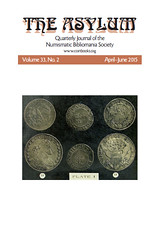 David Yoon is the editor of our print journal, The Asylum. he writes:
David Yoon is the editor of our print journal, The Asylum. he writes:
Another issue of The Asylum is at the printers. Here are the contents:
- David Stone, The Rare Plated Woodin Catalogue: Tom Elder’s Epic Gold Sale
- Ray Williams, Charles Bushnell’s Manuscript “Early Currency”
- Thomas D. Harrison, Édouard Frossard’s Anonymous Auction Catalogues
- David F. Fanning, Off the Shelf: Spasskii’s The Russian Monetary System
For a membership application form, see:
www.coinbooks.org/about/NBS_Membership_Form_2015.pdf
SKLOW MAIL BID SALE #26 CLOSES OCTOBER 10, 2015
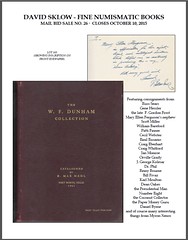 Numismatic Literature enthusiasts! Mail Bid Sale # 26 closes in one short week on Saturday Oct 10th at 8 PM Mountain Time. Be sure to mark
your calendar and submit your bids before the deadline!
Numismatic Literature enthusiasts! Mail Bid Sale # 26 closes in one short week on Saturday Oct 10th at 8 PM Mountain Time. Be sure to mark
your calendar and submit your bids before the deadline!
There over 1000 lots of interesting books, auction catalogs and periodicals to choose from.
Bidding is via email, telephone, fax and USPS. Bids left on our answering service, faxes and email bids received before midnight on closing night will be accepted.
Catalog is available for viewing & downloading on our web site. Bid Early & Bid Often!
David Sklow - Fine Numismatic Books
P.O. Box 6321
Colorado Springs, CO 80934
Phone:719-302-5686
Fax: 719-302-4933
Email: numismaticbooks@aol.com
Website: Finenumismaticbooks.com
THE BOOK BAZARRE
KOLBE & FANNING’S SALE 140 CLOSES NOVEMBER 7, 2015
Kolbe & Fanning’s latest catalogue has been published: our Sale 140, featuring selections from the library of Stephen Epstein, among other properties. The sale features numismatic literature from around the world, and will be held beginning at noon eastern time on Saturday, November 7.
Some highlights from the sale include:
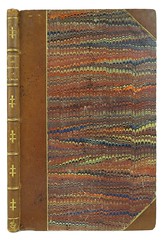

Lot 15: Beaupré’s rare work on the medallist Ferdinand de Saint-Urbain
Lot 70: Friedensburg’s rare three-volume publication on medieval Silesian coins
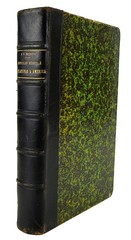
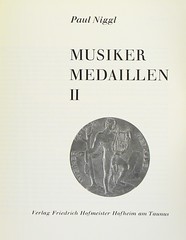
Lot 142: Medina on European medals relating to the Americas
Lots 157 and 158: Niggl’s first and second volumes on musical medals
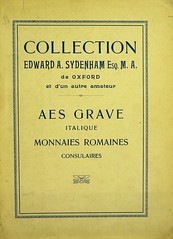
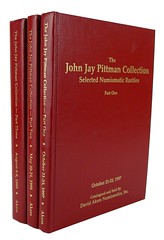
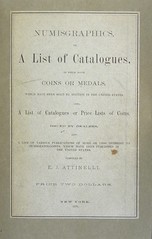
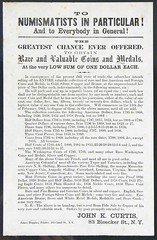
Lot 273: an original copy of Attinelli’s Numisgraphics, ex Ferguson Haines
Lot 314: a framed handbill for an 1861 numismatic lottery scheme by John K. Curtis
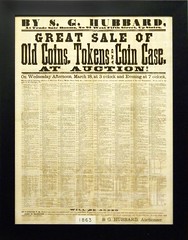
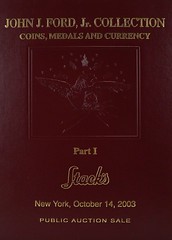
Lot 339: a massive 1863 broadside by S.G. Hubbard, being the first Cincinnati coin auction
Lot 416: a 21-volume hardcover set of John J. Ford, Jr. coin sales (2003-07).
Printed copies of the catalogue are mailing to customers on our mailing list. A PDF of the printed version has been posted on the main Kolbe & Fanning website at numislit.com for anyone wishing to browse the sale or search by keywords. In addition, the sale has been posted to Kolbe & Fanning’s custom online biding platform at auction.numislit.com, where every lot is illustrated in color and where absentee bids can be placed at any time prior to the sale. The live sale will be conducted on the auction.numislit.com site.
As a reminder, bidders may participate in this sale in a variety of ways. Please feel free to send us your bids in the regular mail or send us an e-mail. Give us a call or send us a fax. For those who prefer the experience of live bidding, please check out our live biding platform at auction.numislit.com. Register in advance of the sale and browse the lots at your leisure: all lots are illustrated in the online catalogue. Absentee bids can be placed in advance, allowing participants to not worry about remembering the sale or finding themselves unexpectedly occupied on the day of the sale. Bids will be reduced as competition dictates and the privacy of your maximum bids is maintained. Please contact David Fanning at df@numislit.com with any questions.
BOOK REVIEW: WHO'S WHO AMONG AMERICAN MEDALLISTS
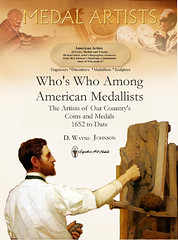 Dick Johnson's: Who's Who Among American Medallists. The Artists of Our Country's Coins and Medals 1652 to Date. by D.
Wayne Johnson
Dick Johnson's: Who's Who Among American Medallists. The Artists of Our Country's Coins and Medals 1652 to Date. by D.
Wayne Johnson
I am sure the book did not start out this way but today it is an interactive catalog of mostly American medallists. The Who's Who is the book with artists listed from Aarons, George Manual to Zorrilla, J and 4,000 others in between. The bios reflect years of compiling data about each artist. Some are quite complete and some are placeholders awaiting more information when available. The book answers the question; Who? The website www.MedalArtists.com answers the question; What? The website is where every artist's work is briefly described and illustrated if possible. By its very nature this is a work in progress, the Wikimedallica of the medal collectors world.
The book arrived in August and I will forever be digesting it. I have been researching one medallist and compiling a catalog of his works for the past 14 years. To compare what Dick Johnson has accomplished to my efforts let me use a stairway analogy. He has reached the top of the Washington Monument and defined the landscape. I am still climbing to the top of a five-flight walk-up. In the Bronx.
This is a first edition of a book that will see many more editions as biographical information is acquired and updated, and a website that will migrate from one digital format to another to remain accessible as it expands and multiplies.
A careful reading of the forward is necessary for the reader to really understand the breadth of the concept described here. Not just a book, not just a website but a marriage of the codex of yore with the informational web platform of tomorrow. It is my hope that the members of the medal collecting community who are often knowledgeable in one small area of Ars Medallica will share that knowledge with the rest of the community via this book/cat-web/cat. Dick Johnson is a generalist and has devoted his life to this grand conjunction. If each of us added our own 2 cents the end result would explode geometrically.
Medallist. On his copyright page Dick Johnson deals with the spelling issue of this word for the designer of a medal. He has opted to use the double L in 'medallist.' This is an elegant solution to spelling 'medallist' in the tradition of The 'Medallic' Art Company and the Society of 'Medallists.' This leaves 'medalist' to the winner of a competitive event. Spell check awarded me a redline under medallist whenever i typed it out until I just added medallist to my dictionary and, poof, the redline went away. Of course, if we all lived in France, they have a perfectly good word, i.e. Medailleur, who is the designer of..., not the winner of.... But then that would be a book of a different cover.
To read the earlier E-Sylum article, see:
NEW BOOK: WHO’S WHO AMONG AMERICAN MEDALLISTS
(www.coinbooks.org/esylum_v18n37a06.html)

BOOK REVIEW: THE COINAGE OF THE SCYTHIAN KINGS
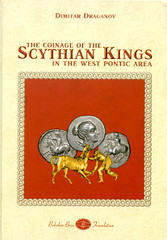 Dimitar Draganov, The Coinage of the Scythian Kings in the West Pontic Area. Bobokov Bros. Foundation. Sofia 2015. 310 pages and 72
plates, full color illustrations, including numerous maps and tables. A4. Hardcover. ISBN 978-954-9460-05-6. 120 euros + postage.
Dimitar Draganov, The Coinage of the Scythian Kings in the West Pontic Area. Bobokov Bros. Foundation. Sofia 2015. 310 pages and 72
plates, full color illustrations, including numerous maps and tables. A4. Hardcover. ISBN 978-954-9460-05-6. 120 euros + postage.
Generally speaking, the world of ancient numismatics is rather simple. It consists of two parts, the Greeks on the one hand, and the Romans on the other hand. Admittedly, the Celts and the Byzantines have managed to develop a life of their own, as it were, but all the other peoples which past generations, rather disrespectfully, used to call “Randvölker” (borderland peoples) almost never make it into the headlines. Yet they form such an essential element of the rich tapestry of the ancient world.
Take the Skythians, for example, which have been the subject of romantic and glorifying descriptions as early as Herodotus. King Ateas, coeval with Philipp II of Macedonia, successfully gained control over almost all Skythian tribes. We do not know for sure how he achieved this diplomatic and military masterpiece. But one thing is certain. He most likely spent as much energy on his campaigns as Philipp II on his conquest of Greece, which, however, found a much greater response by the chroniclers. Furthermore, the Skythian coins continue to be subsumed under the title “Greek Coinage” in all catalogs. This has become a cherished habit, though it surely is historically inaccurate.
Anyhow, the new monograph written by Dimitar Draganov focuses on this intriguing coinage. The first part deals with the coins minted under King Ateas during the first Skythian kingdom which Philipp II destroyed in 339. This part likewise includes the coinage of the city of Dionysopolis, the specimens of which depict an equestrian statue of the king.
The second part examines the coinage of the second Skythian kingdom on the Dobruja, ruled by the members of a single dynasty between ca. 218 and 168/7 BC, including the following kings: Tanousas, Kanites, Akrosas, Charaspes, Aelis, and Sariakes. The author has done fundamental work here. The relative chronology of the rulers of the second Skythian kingdom used to be a matter of scholarly dispute; with this book, Dimitar Draganov not only presents a conclusive reconstruction of the line of succeeding rulers but also gives reliable dates.
Dimitar Draganov studies the depictions of all types of coinage in detail, putting a special emphasis on the countermarks. To put it briefly, the reader is provided with an excellent and lavishly illustrated numismatic commentary. The author likewise benefits from his knowledge of both Western and Eastern languages. He submits a synthesis of the research on this subject-matter and has nevertheless decided to formulate his own findings not in his first language, Bulgarian, but in English instead. The international numismatic community will most likely appreciate this.
This takes us to the die corpus that presents the material neatly arranged and fully illustrated with marvelous images, making the book a valuable standard reference. Every coin dealer, every museum curator will treasure it when he or she is preparing a catalog. What is more, Dimitar Draganov devotes an entire chapter to modern counterfeits. Anyone inclined to think that there was no such thing as a forged bronze coin will be taught better.
To cut a long story short, this book is a new standard work and is a must-have for every library aiming at complying with scientific standards.
To read the complete article, see:
The Coinage of the Scythian Kings in the West Pontic Area
(www.coinsweekly.com/en/News/4?&id=3674)
THOMAS DEO EDWARDS (1894-1946)
Thomas Deo Edwards (1894-1946), was born on April 24, 1894, son of Thomas Edwin Edwards (1864-1940), a farmer, and Izaetta Jane Griffin Edwards (1868-1935) at Eugene, Oregon. He graduated high school and entered the University of Oregon. In December 1927 he applied for membership in the A.N.A. and was given Member No. 3258. In public life he dropped his first name "Edward" and went by his middle name "Deo". In 1926, he was the manager, Hotel Electric, Oregon City, Oregon. In February 1932, he purchased the Tourist Hotel, 524 ½ Main Street, Oregon City, Oregon.
He was a collector specializing in the highest grade U. S. half cents according to his letter dated October 8, 1928 to Henry Chapman, Jr.
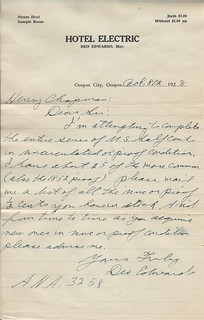 Letterhead of the Electric Hotel with note sent by Deo Edwards to Henry Chapman, postmarked October 8, 1928, 9 A.M., Oregon City,
Oregon.
Letterhead of the Electric Hotel with note sent by Deo Edwards to Henry Chapman, postmarked October 8, 1928, 9 A.M., Oregon City,
Oregon.
"Henry Chapman : Dear Sir : I'm attempting to complete the entire series of U. S. half cents in uncirculated or proof condition. I have about 25 of the more common (also the 1852 proof). Please mail me a list of all the unc. or proof 1/2 cents you have in stock. A note from time to time as you acquire new ones in unc or proof condition please advise me. Yours Truly Deo Edwards A.N.A. 3258"
Over the years he wrote to Henry Chapman buying half cents. What happened to his collection is unknown. He died of apoplexy on March 7, 1946, at age 51, 10 months and 7 days. He is buried in the U. S. veterans burial grounds, Lincoln Memorial Park Cemetery, Portland, Multnomah County, Oregon.
To read the complete article, see:
EDWARDS,
THOMAS DEO (https://sites.google.com/site/numismaticmallcom/encyclopedic-dictionary-of-numismatic-biographies/edwards-thomas-deo)
NOTES FROM E-SYLUM READERS: OCTOBER 4, 2015
Moreau de St. Méry’s American Journey
Philip L. Mossman writes:
I was so pleased that Gawain O'Connor called everyone’s attention to that fantastic book, MOREAU DE ST. MÉRY’S AMERICAN JOURNEY. Although as a fellow Mainer, and a collector of the works of Kenneth Robert, this 1947 classic escaped my attention until 1997 when I was directed to it by Gary Trudgen’s reference in the July 15, 1989 issue of Penny-Wise and by Mike Hodder’s commentary, “Did New Jersey Coppers Officially Circulate in 1792,” published in The Colonial Newsletter (RF-64) [March 1990, sequential page 1152]. I agree with Wayne’s suggestion, based on Gawain’s timely review; this book is “a marvelous find for numismatists.”
This same thinking prompted me to publish my assessment in The Colonial Newsletter [April 1997, pp. 1669-77] which I entitled “More on Moreau.” In my article, I amplified the colonial exchange rates of the period as quoted by Moreau since sometimes these private, individual reports give a better picture of actual day-to-day life as noted by Gawain’s quotations about the Hackensack ferry and daily market prices of common food items. One scary item in this story is that during his escape from unfriendly revolutionary forces in Paris, Moreau cheated the guillotine by a mere eighteen hours ahead of his pursuers by clearing the port of LeHarve on the brig Sophie to Portland, ME! Thank you Gawain for this memory prompt and recommendation to colonial enthusiasts. Read it!
To read the earlier E-Sylum article, see:
BOOK REVIEW: MOREAU DE ST. MÉRY’S AMERICAN JOURNEY
(www.coinbooks.org/esylum_v18n39a08.html)
The Society of the Cincinnati
Bob Fagaly writes:
Regarding the article on the ”THE NATIONAL DEFENSE MEDAL” quoted in the September 27, 2015 issue of The E-Sylum, where it states:
"Marco Islander Lou Stickles is very proud man. He has just been awarded the National Defense Medal by the United Daughters of the Confederacy (UDC), which was established in 1894 and is the oldest patriotic lineage organization in the country.”
I should point out that The Society of the Cincinnati, founded in 1783 predates the UDC by 111 years.
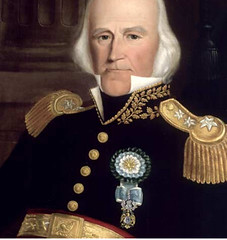 The Society of the Cincinnati is the nation's oldest patriotic organization, founded in 1783 by officers of the Continental Army and
their French counterparts who served together in the American Revolution. Its mission is to promote knowledge and appreciation of the achievement of
American independence and to foster fellowship among its members. Now a nonprofit educational organization devoted to the principles and ideals of
its founders, the modern Society maintains its headquarters, library, and museum at Anderson House in Washington, D.C.
The Society of the Cincinnati is the nation's oldest patriotic organization, founded in 1783 by officers of the Continental Army and
their French counterparts who served together in the American Revolution. Its mission is to promote knowledge and appreciation of the achievement of
American independence and to foster fellowship among its members. Now a nonprofit educational organization devoted to the principles and ideals of
its founders, the modern Society maintains its headquarters, library, and museum at Anderson House in Washington, D.C.
Bob adds:
I note you show the portrait of Gen. Morgan Lewis wearing George Washington’s Diamond Eagle (the eagle is the badge (actually an order) of the Society). Featured on the cover of Rulau and Fuld’s Medallic Portraits of Washington, it is arguably the most valuable piece of Washingtonia in existence.
For more information on The Society of the Cincinnati , see:
The Society of the Cincinnati (www.societyofthecincinnati.org)
To read the earlier E-Sylum article, see:
THE NATIONAL DEFENSE MEDAL (www.coinbooks.org/esylum_v18n39a25.html)
Pince-Nez in Numismatics
Pete Mosiondz writes:
Thanks for another great E-Sylum. I too am a Sherlock Holmes aficionado. I always had trouble pronouncing pince-nez (a pair of glasses without sidepieces, held in place by a clip that fits over the nose). I have been told that it is pronounced pons-nay. If I recall correctly, one of the Jeremy Brett episodes mentioned them likewise.
To read the earlier E-Sylum article, see:
PINCE-NEZ IN NUMISMATICS (www.coinbooks.org/esylum_v18n39a31.html)
Alan David Craig Information Sought
Bruce Smith writes:
I am working on my bibliography on Chinese numismatics and have come to Alan David Craig. He was born in 1930, wrote a still important book, "The Coins of Korea" (1955), and for a few years in the late 1950's published the Far East Numismatic Digest. He lived in Berkeley, California and was in the U.S. military in Korea during the Korean War. I believe he died in 1999. Can anyone confirm this? His Coins of Korea was reprinted in 2011 by Ishi Press in New York, which has reprinted some other numismatic works in the past few years.
Panama 1941 One Balboa Note Census
Pablo Hoffman writes:
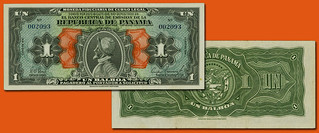 “The P M G Census records just 72 known . . . “ This alludes to the Panama 1941 One Balboa note, referenced in an article quoted in the
September 13, 2015 issue of The E-Sylum.
“The P M G Census records just 72 known . . . “ This alludes to the Panama 1941 One Balboa note, referenced in an article quoted in the
September 13, 2015 issue of The E-Sylum.
The reference archives of Nuevo Mundo World Paper Money lists 229 issued examples of these notes that have been observed and recorded by serial number (including the one pictured in the cited article, #002093.) This archive list has not been kept current since almost ten years ago, and more examples have surfaced in the interim.
Collectors should be skeptical and selective about considering any “census” figures as authoritative or indicative of actual population.
To read the earlier E-Sylum article, see:
QUERY: DENOMINATIONS NAMED AFTER PEOPLE
(www.coinbooks.org/esylum_v18n37a27.html)
Eurozone Nation Coin Designs
Jeff Starck of Coin World writes:
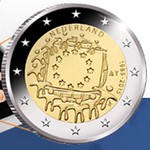 I couldn’t help but notice your comments about the new circulating commemorative 2-euro coin. The example from the Netherlands was shown in
the Sept. 20 E-Sylum. “I guess one could appreciate the simplicity of the design, but the human figures are too abstract for my taste - these
are little beyond stick figures. -Editor “
I couldn’t help but notice your comments about the new circulating commemorative 2-euro coin. The example from the Netherlands was shown in
the Sept. 20 E-Sylum. “I guess one could appreciate the simplicity of the design, but the human figures are too abstract for my taste - these
are little beyond stick figures. -Editor “
What was not stated in your report is the fact that ALL Eurozone nations are issuing this design, and that it was selected in an EU-wide online vote. See this earlier Coin World report for the full story.
To read Jeff's Coin World article, see:
Residents choose
design to celebrate European Union flag anniversary on circulating €2 coin
(www.coinworld.com/news/world-coins/2015/05/residents-choose-design-for-european-union-flag-anniversary-circ.html#)
To read the earlier E-Sylum article, see:
SOME RECENT COIN DESIGNS: SEPTEMBER 20, 2015
(www.coinbooks.org/esylum_v18n38a27.html)
A Mathematical Coin Puzzle
 Regarding the coin puzzle Gosia Fort shared in the September 20th issue, Pete Smith writes:
Regarding the coin puzzle Gosia Fort shared in the September 20th issue, Pete Smith writes:
Obviously the images in the item were drawings, not photographs. I attempted to identify the coins without success.
To read the earlier E-Sylum article, see:
(www.coinbooks.org/esylum_v18n38a09.html)
Daniel Coit Gilman and the ’91 Club
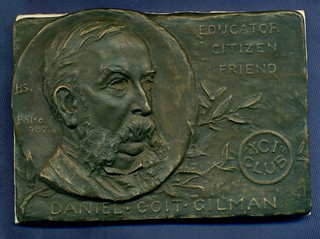
Greg Ruby writes:
In regards to the Daniel Coit Gilman plaque, I always referred to it as the XCI Club medal, not realizing that this was the roman numeral 91. I came across Fabian Franklin’s The Life of Daniel Coit Gilman about 15 years ago. While reading that work, it mentions how Gilman gathered a group of young men to take up management of the Mercantile Library. These men went on to form a social club, the ’91 Club that would meet irregularly 3-4 times each winter to enjoy dinner and a roundtable discussion. The biography states that the bronze portrait was presented to Mrs. Gilman at the last meeting of the ’91 Club in the winter of 1907-08 It’s a beautiful work by Schuler and a prized item in my collection.
To read the earlier E-Sylum article, see:
JOHNS HOPKINS MEDALS (www.coinbooks.org/esylum_v18n39a24.html)

WILL THE REAL M.E. HART PLEASE STAND UP? PART 2
Last week Mike Locke and Dan Owens wrote:
The following draft (in two parts) is a research paper on the M.E. Hart Co. without a definitive conclusion. We are asking readers of The E-Sylum for their help in solving this mystery. If you come across any M.E. Hart Co. advertisements, Shreve & Co. employee records from 1915-1916, or contemporary numismatic publications that reveal the namesake or provide additional information regarding the M.E. Hart Co., we request that you publish your findings in The E-Sylum, or send them to us via the email link on www.calgoldcoin.com. Thanks in advance for your assistance.
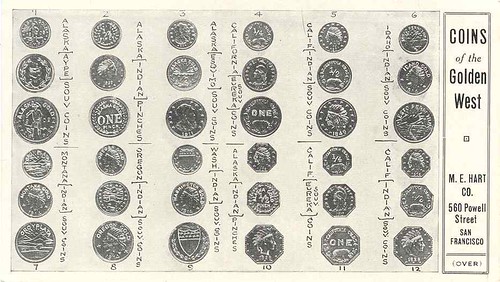
Mike Locke and Dan Owens research paper, compiled by Dan Owens.
Zerbe and Hart Cross Paths. Early on in our search, we tried to find a concrete link between Mary E. Hart and Farran Zerbe. As Hyder pointed out in his article, it is certainly plausible that they crossed paths in their travels. Noted ANA member Edgar H. Adams wrote in the October 1915, edition of The Numismatist that he, Zerbe and other ANA members toured the Expo together during the ANA convention noting visits to a number of displays including representations of Yellowstone, the Grand Canyon and a Mexican village.
Zerbe's Money of the World exhibit housed in the Liberal Arts building was the “Mecca” for the members. ANA members also visited the Italy, France, Cuba and Canada buildings with the Canadian display being chosen by members as being the best. Adams did not mention if they stopped by the Alaska exhibits.
At the Lewis & Clark Centennial held in Portland Oregon from June to October 1905, the floor plan shows that the American Numismatic Association's exhibit with Zerbe serving as agent was positioned right next to the Pacific Coast Steamship Co.'s Alaska Exhibit.
 In two separate stories published in the Daily Alaska Dispatch in January 1905, Mrs. Hart allegedly had gotten into a dispute with
Alaskan Governor Brady during the 1904 Louisiana Purchase Exposition held in St. Louis. She had been appointed to organize, manage and host the
Alaska display there but reportedly would not be connected with the Government sponsored Alaska exhibit at Portland.
In two separate stories published in the Daily Alaska Dispatch in January 1905, Mrs. Hart allegedly had gotten into a dispute with
Alaskan Governor Brady during the 1904 Louisiana Purchase Exposition held in St. Louis. She had been appointed to organize, manage and host the
Alaska display there but reportedly would not be connected with the Government sponsored Alaska exhibit at Portland.
However, the Oregonian on June 11th, 1905, noted that Mrs. Hart was invited to spend a week at the Expo because of her hostess role in St. Louis. There is no doubt that she would have been attracted to the Pacific Coast Steamship Companies Alaska display and most certainly would have crossed paths with Farran Zerbe in the next booth.
Candidate No. 3 Bruno Ferdinand Fera was born in New Jersey on September 1st, 1873. His resume included a stint as a Manhattan New York jeweler before he worked as a department manager for Shreve & Co. in San Francisco for a number of years. Shreve & Co. made the copper framed cases that some of the Coins of the Golden West token sets were housed in. In addition they manufactured a similar style case for the Panama Pacific International Exposition Commemorative coin set in both single and double sizes. The double sized case allowed both the obverse and reverse of the coins to all be displayed on one side.
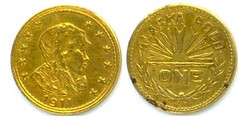 In 2014, lot 2114, in the Stack's Bowers Americana Sale was an original copper frame for a ten piece or double size 1915 Panama Pacific
commemorative coin set. On the back of this extremely rare item was a sticker reading COINS/OF THE/GOLDEN/ WEST/M.E. HART/CO./560
POWELL/STREET/SAN/FRANCISCO/, with a handwritten price of $12. Hence the M.E. Hart Co. also sold all of the various cases for the P.P.I.E. coins.
In 2014, lot 2114, in the Stack's Bowers Americana Sale was an original copper frame for a ten piece or double size 1915 Panama Pacific
commemorative coin set. On the back of this extremely rare item was a sticker reading COINS/OF THE/GOLDEN/ WEST/M.E. HART/CO./560
POWELL/STREET/SAN/FRANCISCO/, with a handwritten price of $12. Hence the M.E. Hart Co. also sold all of the various cases for the P.P.I.E. coins.
More importantly, Fera was listed in the 1915 and 1916 San Francisco City Directories at 560 Powell street. Thus he was at the right place at the right time and in all likelihood rubbed elbows with the proprietor of the M.E. Hart Co.
The Chesterfield Apartments did not house that many tenants. Was the 560 Powell street address a post office box drop off for the M.E. Hart Co. or did someone with the last name of Hart in fact live in the building?
Candidate No. 4 On April 26th, 1916, the San Jose Evening News wrote that Mrs. Marie Hart was reportedly awakened at 4 o'clock in the morning and found a burglar at work in her room at the Chesterfield Apartments, 560 Powell street. She jumped out of bed and made a rush at the thief, but the burglar beat her to the door and ran out into the street.
Thus she stepped forward into the light, as the most promising candidate for the long lost token dealer. Marie Hart was at the right place, at the right time and had the correct first initial and last name.
Did Mrs. Marie Hart like Mr. Fera work for Shreve & Co? A follow-up search through five contemporary newspapers for additional information about the attempted burglary, revealed no further news reports. At this point, a subsequent search through genealogy records has failed to yield anything of value.
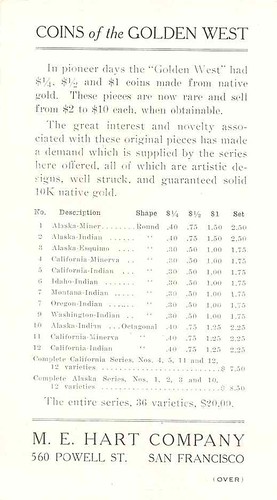 Thus we began to look back and wonder if Marie Hart was a reporter's misinterpretation of Mary E. Hart. She certainly had the
personality of someone who would chase a burglar from her room. Even though the apartments appear to have been upscale, they did have a transitory
nature to them. On the other hand, if this was true, why didn't the reporter identify her as the so-called first lady of Alaska? She was well
known to the press having written and or appeared in dozens of news items over the years.
Thus we began to look back and wonder if Marie Hart was a reporter's misinterpretation of Mary E. Hart. She certainly had the
personality of someone who would chase a burglar from her room. Even though the apartments appear to have been upscale, they did have a transitory
nature to them. On the other hand, if this was true, why didn't the reporter identify her as the so-called first lady of Alaska? She was well
known to the press having written and or appeared in dozens of news items over the years.
We did find that Mary E. Hart, the journalist had spent the first four months of 1916 in Missouri visiting relatives before returning sometime in April to Corte Madera. In 1916, she listed her in town address as the Palace Hotel. Thus Mary E. and Marie Hart could have been two separate individuals.
Coincidentally, in a 1920 San Francisco Commonwealth Club membership list, the name of T.W.H. Shanahan, Superintendent of the San Francisco Branch Mint, can be found listed at the 560 Powell Street address. Just who was the proprietor of the M.E. Hart Co.? The evidence points to Farran Zerbe, along with the assistance or namesake of Mary E. Hart, Bruno Fera, Marie Hart, or a combination of the preceding names? However, like William Hyder we have not yet found the fabled "smoking gun" that positively identifies that person or persons.
I would like to thank Robert Leonard for his helpful suggestions.
All images except 560 Powell Street, courtesy of Mike Locke at www.calgoldcoin.com
To read the earlier E-Sylum article, see:
WILL THE REAL M.E. HART PLEASE STAND UP? PART 1
(www.coinbooks.org/esylum_v18n39a15.html)
COLLECTING CATALOGS OFFERING 1804 DOLLARS
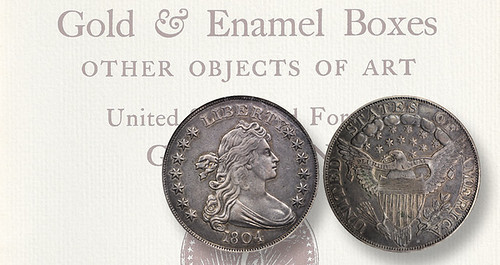
Back in May, the Numismatic Bookie bought an 1804 silver dollar for $15. OK, it was really my wife, Florence, who made the purchase, and the 1804 dollar was actually photographed in an auction catalog. This experience, however, illustrates how you can build an important numismatic library without breaking your budget.
Antique fairs, flea markets, book sales: bargain-priced numismatic literature hides in them all. We attended the annual Rhinebeck, New York antiques fair, but it could have been any sale, anywhere. Florence spied a Parke-Bernet catalog featuring an 1804 dollar (although its cover depicted a 1907 Saint-Gaudens, Roman Numerals double eagle), at a dealer’s booth, and quickly paid the $15 asking price.
Not only was Florence’s find a bargain, it was also inspiring. The 1804 Draped Bust dollar — “The King of American Coins” as dealer B. Max Mehl called it — has been the straw that stirs a coin collector’s drink ever since the first one was revealed in 1842. One of the greatest numismatic books ever written — The Fantastic 1804 Dollar — exposed this storied coin as a novodel, struck illegally long after the date on its face, but nonetheless, at every public auction appearance, a bidding frenzy erupts. So why not try collecting one copy of every auction catalog offering an 1804 dollar for sale?
If you love challenges, this one will turn your crank. You’ll need to find more than 50 catalogs, ranging in age from 148 years to few months, and in price from hundreds to the $15 Florence paid. Most are American, some British, and one is German. Most are relatively common, some are rare and expensive, and a few are uncommon, yet inexpensive. It will take years of work with numismatic literature dealers, but when finished, you’ll have a superb catalog collection.
Two “keys” are required to complete such a set. The first is the oldest: W. Elliot Woodward’s sale of the Joseph J. Mickley Collection, Oct. 28, 1867. The second is the rarest: Adolph Weyl’s sale of Oct. 13, 1884, which featured, glued to its cover, a photograph of a plaster cast of the 1804 dollar known as the Dexter specimen. Why photograph a plaster cast instead of the real coin? No one knows, although theories abound.
The Parke-Bernet catalog offers a different example, the Davis specimen. After Philadelphia numismatist Robert Coulton Davis purchased this coin from John Haseltine in 1877, he sought assurance from the U.S. Mint that it was an “original” coin (today called a Class 1 dollar, struck around 1834). Mint Assayer William Dubois compared the Davis specimen (today called a Class III dollar, struck around 1858), with the Class I dollar in the Mint Cabinet (museum), and declared that Davis owned an “original” issue. Dubois was a knowledgeable numismatist and longtime curator of the Mint Cabinet who knew the differences between Class I and Class III 1804 dollars, which are readily obvious upon comparison. Dubois simply lied to Davis.
Too bad for Mr. Davis, but good for us. The story of 1804 dollars is chock-a-block with intrigue, skullduggery, and double-dealing. A collection of such catalogs provides hours of fascinating reading as you trace how people over decades pieced together the truly fantastic history of the 1804 dollar.
To read the complete article, see:
Collecting
auction catalogs offering 1804 dollars: Numismatic Bookie
(www.coinworld.com/news/us-coins/2015/10/collecting-auction-catalogs-offering-1804-dollars--numismatic-bookie.html#)
ON AUCTION CATALOG WEIGHT
Auction catalog weight — it’s not lumber doing that
— its dirt ( Well, OK, clay)
Ever ask yourself: Wait a minute, books are made out of paper and paper is made out of wood. So why is this coin auction catalog heavier than a similar-sized plank of wood? The reason those beautiful auction catalogs are so darn heavy I learned from my old field of advertising which involved a lot of coordination with printers: Clay coated paper.
NOTE: I am a new NBS member, and over the last two months I have read every E-Sylum of the last 15 years and seen no mention of catalog paper weight — thus here you go!
This advertising device I dealt with during more than 25 years as an advertising agency owner. Those wonderful glossy catalogs with those razor-sharp images are printed on the nicest paper stock for photos which is called coated stock. Coated with what? The coating is white clay. So you could say that is a type of dirt, or mud or pottery being added to wood pulp and doubling the weight of the basic paper’s ground wood.
If photographs are just sort-of important, the book can be printed on a nice uncoated stock. But when many millions of dollars worth of coins and banknotes are being illustrated, only razor-sharp, vibrant reproduction of four-color images will do.
Coated papers have a smooth clay coating applied over the groundwood base paper. The base paper is made first, then put through a bath of clay coating while running on a machine, followed by calender rollers smoothing out the coating and adding as much as half the weight of the paper.
Coated papers are categorized into grades by their brightness and gloss levels, but they all add a lot of weight because of the clay coating. The coating is finished to a high gloss, or it may be matte, or dull. The most expensive of the coated papers are the heaviest — and those coin auction companies do not cut corners.

Archives International Auctions, Part XXIX
U.S. & Worldwide Banknotes, Scripophily, Coins,
Historic Artifacts & Ephemera, Artwork, Autographs
and Security Printing Ephemera
October 24th & 29th, 2015
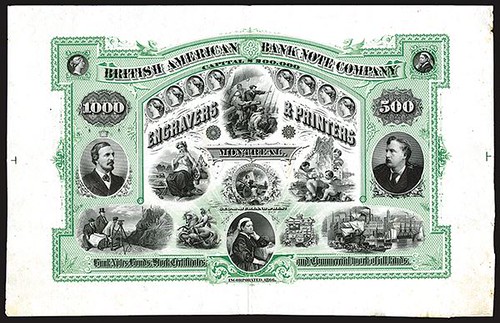
Click the links! Highlights include:
- Lot 26: Thomas Spencer - Honolulu - Sandwich Islands 1858
- Lot 320: Accelerating Steam Navigation Co. 1841 Ten shares
- Lot 363: Confederate States Bond. $10,000. Cr.146, B-339.
- Lot 413: First Liberty Loan Converted 4 _% Gold Bond of 1932-1947
- Lot 607: Fijian Government Debenture, 1872 Issue
- Lot 715: Bono De Caja, El Banco Comercial Refaccionario De Chihuahua
- Lot 738: Banco Nacional Del Peru, 1877 Provisional Issue Specimen
- Lot 809: Bank of Zambia, ND (1964) Specimen Banknote.
- Lot 948: British American Bank Note Company Engravers & Printers Proof
- Lot 960: Draper, Underwood, Bald & Spencer, ND, ca.1820's Sample Sheet.
- Lot 1000: Colonial Pennsylvania, 15 Shillings 5.20.1758.
- Lot 1056: Cherokee Insurance & Banking Co. 2 Dollars. 1862.
- Lot 1139: Bank of America, 1879 Specimen $10,000 Clearing House Certificate.
- Lot 1148: Manufacturers Bank, 184x Proof Banknote on a Proof Vignette Sheet
- Lot 1229: Confederate States. 5 Dollars. 1861.
- Lot 1280: Legal Tender Note. 1863 Series. 5 Dollars.
- Lot 1298: Hackettstown National Bank of NJ., Second Charter $10.00
View the Virtual Catalog
Download the Catalog in PDF format
ARCHIVES INTERNATIONAL AUCTIONS, LLC
1580 Lemoine Avenue, Suite #7
Fort Lee, NJ 07024
Phone: 201-944-4800
Email: info@archivesinternational.com
WWW.ARCHIVESINTERNATIONAL.COM
SLATE FEATURES THOMPSON'S BANK NOTE REPORTER

On September 28, the online magazine Slate commented on Thompson's Bank Note Reporter, one of a class of publications created in the antebellum period to combat spurious bank notes. The author accessed the publication via the Newman Numismatic Portal, which recently scanned this publication from the Eric P. Newman library. Quoting from the article:
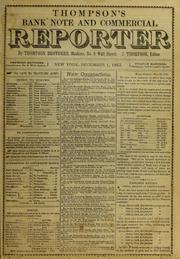 "Four pages from the publication Thompson's Bank Note Reporter, issued in February 1846, give a sense of the wide range of
currencies available in the United States during the so-called free banking era. (The full 16-page issue, which covers currency from 27 states, D.C.,
and Canada, is available on the Internet Archive, having been digitized by Washington University Libraries.) "Thompson's Reporter was one of
a class of newspapers that existed solely to catalog and assess types of currency during the period between the decline of the Second Bank of the
United States, in 1836, and the emergence of a national currency after the Civil War. The range of notes classified in the Reporter reflects the
number of entrepreneurs that stepped into that breach.
"Four pages from the publication Thompson's Bank Note Reporter, issued in February 1846, give a sense of the wide range of
currencies available in the United States during the so-called free banking era. (The full 16-page issue, which covers currency from 27 states, D.C.,
and Canada, is available on the Internet Archive, having been digitized by Washington University Libraries.) "Thompson's Reporter was one of
a class of newspapers that existed solely to catalog and assess types of currency during the period between the decline of the Second Bank of the
United States, in 1836, and the emergence of a national currency after the Civil War. The range of notes classified in the Reporter reflects the
number of entrepreneurs that stepped into that breach.
"Business owners or private citizens could use the Reporter to perform their own assessments of currency, comparing the note in front of them to the Reporter's visual description of known counterfeits, or to assess whether the Reporter thought the bank was in danger of going under anytime soon."
To read the complete article, see:
Behold
the Confusing Diversity of American Banknotes During the Antebellum Era (www.slate.com/blogs/the_vault/2015/09/28/history_of_
free_banking_a_list_of_banknotes_from_the_antebelleum_era.html)
COUNTERFEIT 1972 DOUBLED DIE LINCOLN CENT
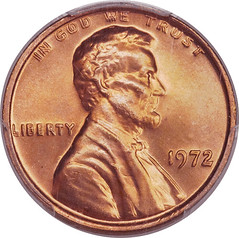
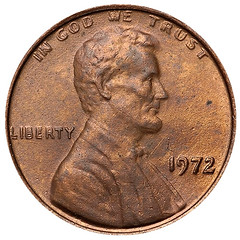
Genuine and Fake 1972 Doubled Die Lincoln Cents
There are a handful of varieties that are regularly seen faked, including the Philadelphia and Denver 1942/41 Mercury Dimes, the 1955 Doubled Die Cent, and the 1937-D Three-Legged Buffalo Nickel, though the latter is typically an alteration rather than an outright counterfeit. Counterfeits of other varieties are not particularly common, however, and can sometimes catch you off guard.
NGC recently received a fake 1972 Doubled Die Cent, which is not something that we see often. There are actually several varieties of doubled die obverse 1972 cents, but the most popular is FS-101 because of the extremely pronounced doubling on the date and mottos. Many collect this doubled die as part of the regular series, and as of 5/21/12 NGC has graded nearly 2,000 examples. According to the NGC US Coin Price Guide, even a low grade example sells for a few hundred dollars.
Those familiar with the 1972 Doubled Die will be able to identify this counterfeit with ease. Instead of the bold doubling seen on genuine examples, this piece has weakly defined legends that blend into the fields. The surfaces also have a pockmarked appearance with raised lumps, particularly around IN GOD WE TRUST and the N in ONE. Familiarity with the look of genuine specimens certainly helps, but the soft details and raised areas on this piece are telltale signs that it is a counterfeit.
To read the complete article, see:
Counterfeit Coin
Detection – The 1972 Doubled Die Lincoln Cent
(www.coinweek.com/us-coins/us-small-cents/counterfeit-coin-detection-the-1972-doubled-die-lincoln-cent/)

THE NEW ORLEANS MINT UNDER SOUTHERN FLAGS
March 15, 1861, The Hancock Jeffersonian (Findlay, Ohio)
 Gold from the New Orleans Mint--A Communication from J. Ross Snowden, Director of the Philadelphia Mint, addressed to the Secretary of the
Treasury, under the date of February 18th, appears in the Philadelphia Press. Mr. Snowden recommends that the coinage of the New Orleans Mint be
declared no longer a legal tender, inasmuch as the Mint has been seized by the state authorities and is no longer a federal institution. This
important proposition is set forth as follows:
Gold from the New Orleans Mint--A Communication from J. Ross Snowden, Director of the Philadelphia Mint, addressed to the Secretary of the
Treasury, under the date of February 18th, appears in the Philadelphia Press. Mr. Snowden recommends that the coinage of the New Orleans Mint be
declared no longer a legal tender, inasmuch as the Mint has been seized by the state authorities and is no longer a federal institution. This
important proposition is set forth as follows:
“It appears that the institution in question is not conducting its operation in a lawful manner, and although it is still a branch of the Mint of the United States, (for no action of the Louisiana can legally alter its relation to the general government) yet, as its coin-age from the close of the month of January will not be subject to the tests required by law, it has practically ceased to be a branch of this Mint—The coinage of that branch is designated by the letter “O” on the re-verse side of each piece. The coins struck in January are legal coins of the United States; but as these pieces can-not be distinguished from others coined since that time, having the date of 1861, the whole coinage of the year ought to be discredited by the government.
The announcement should be made, either by the President, or by act of Congress, if the former should not be deemed proper, that the coins of the branch mint at New Orleans of the year 1861 are not of the coinage of the United States, and are therefore not a legal tender in the payment of debts; said coins are designated by the letter “O” on the reverse of each piece.
“I may here state that the coins stamped at San Francisco are designated by the letter “S”; those of Dahlonega (Georgia) by the letter “D” and of Charlotte (North Carolina) by the letter “C”. The coinage of the mint at Philadelphia may be known by the absence of any letter or mint mark.”
If Director Snowden’s proposal had taken traction, all the 1861-O half dollars and Twenty Dollar pieces, regardless of which Government or State had issued them, would have been declared no longer a le-gal tender, and refused to be accepted by the United States for any dues or customs. Apparently Dahlonega and Charlotte were still considered loyal, or possibly thought not to have struck coins and therefore are not addressed in the Director’s appeal.
While this proposal appears to have gone nowhere, the Post Office in August 1861 came out with re-designed U.S. postage stamps and instituted a short period for exchanging old stamps for new, and then demonetized all previous U.S. postage stamps. To this day, the postage stamps issued by the U.S. Government previous to 1861 cannot be used as valid postage. The reasoning was the CSA could raise considerable sums of money by selling U.S. postage stamps that were recovered from taken over Post Offices located in the South. The new Confederate States of America Post Master General in April 1861, ordered all Post Offices in his charge to return all U.S. postage on hand back to Washington, D.C. Few apparently complied with his directive.
For more information on the Liberty Seated Collectors Club, see:
www.lsccweb.org
MORE ON GEORGE THOMAS MCCOMBE, JR.
 It was reported in the Poughkeepsie Daily Eagle, November 8, 1883, that McCombe exhibited an 1804 Dollar. (Not cited by Eric P. Newman and
Kenneth Bressett). The next we hear of an 1804 Dollar is eleven months later, the so-called Adolph Weyl specimen at Berlin, Germany. There were
several counterfeit 1804 Dollars in circulation by 1883. It is unknown at this time if the 1804 Dollar exhibited by McCombe was a counterfeit or one
of the genuine specimens that has not been recorded in its respective provenance.
It was reported in the Poughkeepsie Daily Eagle, November 8, 1883, that McCombe exhibited an 1804 Dollar. (Not cited by Eric P. Newman and
Kenneth Bressett). The next we hear of an 1804 Dollar is eleven months later, the so-called Adolph Weyl specimen at Berlin, Germany. There were
several counterfeit 1804 Dollars in circulation by 1883. It is unknown at this time if the 1804 Dollar exhibited by McCombe was a counterfeit or one
of the genuine specimens that has not been recorded in its respective provenance.
McCombe died at his home on High Street, Lockport, New York, of Typhoid fever on August 21, 1908. He was survived by his wife Sarah, his two sons George, Jr., and Howard and his two brothers William and Frederick.
Joel Orosz adds:
Julia Casey's research skills are impressive! Since McComb's name has not turned up in any of the 1804 provenance chains, I suspect that he had one of the spurious examples.
Dave Hirt adds:
I was interested in the Chapman's address on the letter, of 2043 Tower Street. That was their first address as coin dealers, when they were still really boys. That is not in the Philadelphia business district, but along the Schuylkill River in a section of the city called Manayunk. Perhaps it was their parents' home.
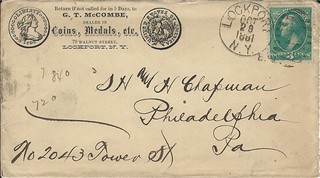
To read the updated Encylopedia article, see:
McCOMBE,
GEORGE THOMAS (https://sites.google.com/site/numismaticmallcom/encyclopedic-dictionary-of-numismatic-biographies/mccombe-george-t)
To read the earlier E-Sylum article, see:
GEORGE THOMAS MCCOMBE, JR. (www.coinbooks.org/esylum_v18n39a10.html)
SUBSCRIBER PROFILE: JULIA CASEY
I'm still new to numismatics and while I am a member of a few Yahoo discussion groups I haven't yet been to any shows or meetings of any clubs so I haven't had the opportunity to meet any other collectors / researchers in person.
I have a background in genealogical research (self taught) and amateur archaeology (some formal training). I enjoy metal detecting and have spent a few years now on message boards assisting other detectorists to identify their finds. It is amazing how much I have learned from that activity!
I was an American history major in college and I have a JD. I practiced real estate law for about 10 years but thankfully I no longer do (yay!). I have two sons, aged 10 & 12 and my husband works in law enforcement.
I collect contemporary counterfeit coins - mainly George II & III halfpennies. I also study Canadian colonial tokens and Victoria large cents. And recently have branched into Hard Times Tokens as a result of my research into Edward Hulseman and Benjamin True. Oh and I have a small but interesting (to me!) collection of coins that have been stamped, engraved, altered or made into things.
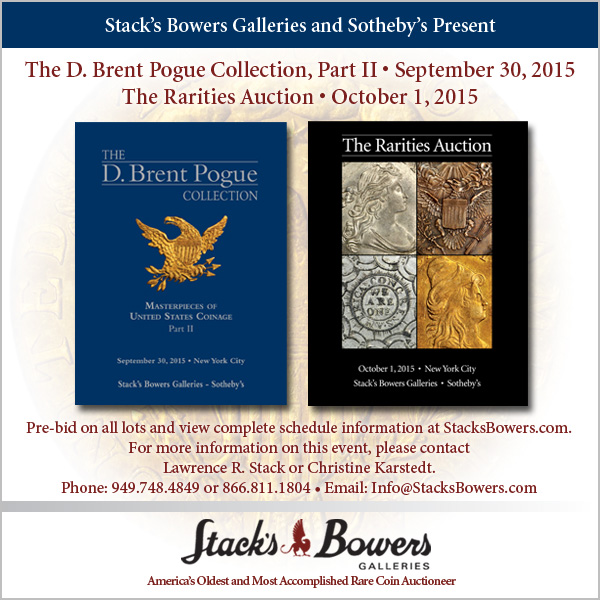
SIR THOMAS GRESHAM AND “GRESHAM’S LAW”
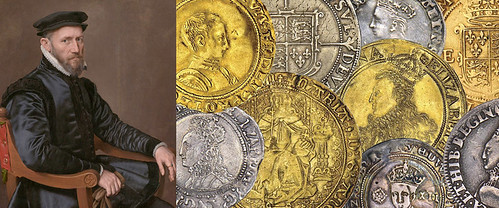
Question: At a recent coin show I overheard a coin dealer tell another dealer that the two coins he had were excellent examples of “Gresham’s Law.” I’ve heard of “Gresham’s Law” before, and wondered if it was anything like the old-time “Murphy’s Law” we’re all familiar with.
Answer: It’s not surprising you heard “Gresham’s Law” at a coin show, as it deals directly with coins. Sir Thomas Gresham (circa 1519- November 21, 1579) was an English merchant and financier who worked closely in the finance of the British Isles with King Edward VI and the king’s half-sisters, Queen Mary I and Queen Elizabeth I. Gresham’s “law” was simple and direct, and still holds true today after nearly 450 years.
Simply put, Gresham’s Law states that bad money drives good money out of circulation. In other words, and in Gresham’s own words, it is simply: “The tendency, when two or more coins are equal in debt paying power but unequal in intrinsic value, toward hoarding the more valuable, thus leaving the less valuable in circulation.” We all have heard the old English saw that “bad pennies drive good pennies out of circulation,” which is simply another way of stating Gresham’s Law. The next time you hear of Gresham’s Law, you will be privy to its actual meaning.
To read the complete article, see:
"Greshams
Law" (www.stacksbowers.com/NewsMedia/Blogs/TabId/
780/ArtMID/2678/ArticleID/65382/Greshams-Law.aspx)
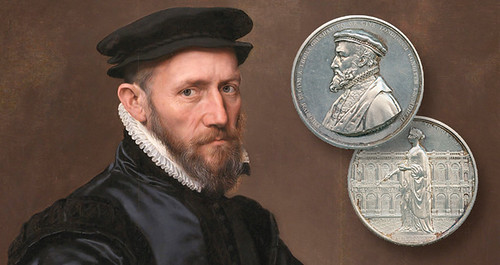
Gresham — whose principle explains the existence of numismatic collectibles like Civil War tokens and the Holey dollar — also makes a brief numismatic appearance, on a 1844 silver medal for the opening of the Royal Exchange.
An Extremely Fine example of the medal realized £432 ($668 U.S.) during a Sept. 23 auction by A.H. Baldwin & Sons Ltd.
The price reflects the 20 percent buyer’s fee.
The medal was issued to celebrate the new building for the Royal Exchange, a center of commerce in London. The current structure, completed in 1844, is the third built on the original site proposed by Gresham. The exchange was rebuilt twice, once following the Great London Fire in 1666 and again after another fire in 1838.
William Wyon designed the medal, which shows Gresham on the obverse, paired with the statue of Queen Victoria before the new façade of the Royal Exchange on the reverse.
The medal measures 74 millimeters in diameter and is cataloged as Eimer-1390 by Christopher Eimer in British Commemorative Medals and Their Values.
How important was the reopening of the Royal Exchange? According to Eimer, this medal was one of more than 20 issued to commemorate the opening of the Exchange. The building was a major work by architect Wiliam Tite.
To read the complete article, see:
British
medal for commercial center opening celebrates economist known for Gresham’s Law (www.coinworld.com/news/world-coins/2015/10/
british-medal-for-commercial-center-opening-celebrates-creator-o1.html)
THE PRINT BOOK DOOMSAYERS ARE WRONG
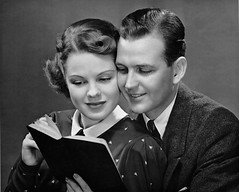 Print book lovers have suffered long under the rise of ebooks and the smug condescension of tech idealists, happy to remind old-school
readers that their beloved format is headed the way of the record or the VHS tape.
Print book lovers have suffered long under the rise of ebooks and the smug condescension of tech idealists, happy to remind old-school
readers that their beloved format is headed the way of the record or the VHS tape.
The death of books has been so completely taken for granted by many that a genre’s ebook sales have been used to argue for a genre’s relevance, or irrelevance, to younger readers.
Well, um, maybe rethink that one? According to The New York Times, print book sales are holding steady in 2015 -- and ebook sales have hit a wall. “Digital books accounted last year for around 20 percent of the market, roughly the same as they did a few years ago,” writes Alexandra Alter. In fact, “E-book sales fell by 10 percent in the first five months of this year, according to the Association of American Publishers.”
As a print book lover and advocate, can I just say, with respect: I TOLD YOU SO I TOLD YOU SO I TOLD YOU SO! Ahem. Sorry about that.
It’s frustrating, as a millennial reader, to see commentators assuming that we can’t even read a book unless it’s presented to us on a screen. In fact, as I was writing this, I overheard a young colleague, who covers sports for HuffPost, casually remark, “I like to read a physical book, not just read on my phone.” Paper isn’t just the refuge of the old fogy. As Alter points out, studies suggest even digital natives prefer to read on paper.
I feared the day with no print books would come, but never really believed it. Despite all the comparisons to VHS, records and CDs, I knew readers didn’t feel the same way about their books.
To read the complete article, see:
11 Simple Reasons The Print Book Doomsayers Are
Wrong (www.huffingtonpost.com/entry/ebook-sales-drop_5603f7e4e4b00310edfa20b8)
QUERY: PRESS RUN FOR A NEW BOOK ON NUMISMATICS
Your advice is needed:
How do we evaluate the press run of a new book on numismatics?
First of all, I have read the sad tale of the NBS member who published far too many of his arcane work and now lives with a pallet or two of books in his garage. Caution prevails.
- The book is the only Spanish-English / English-Spanish numismatic dictionary available.
- I sold 1000 copies of its small, Spanish-English only predecessor in 1966 from California.
- The plan has been to print 1000 books for Europe and 1000 for the USA and the Americas.
- I can produce either 1,000 or 2,000 serial numbered copies. The price to print 1,000 books here in Spain is $2700. The price for 2000 is $4300. Shipping to the USA about $500 at this point.
- The book is a 17 cm x 24 cm format, 208 pages with ample black & white photos throughout.
- The book will have a sewn spine, plastic coated heavy paper cover in full color with fold-out wings. Price: $25
- Publication timetable: Completion of my research/writing will be in November this year.
- I will be happy covering my costs during the first year and distribute the remainder in the coming decade.
The purpose and scope of my research/writing is to provide the numismatic world with a new Spanish-English dictionary of our field’s terminology to bring Spanish–speaking and English-speaking collectors and scholars closer together and more conversant in the two languages.
The quality of the book is extremely important to me, and I believe examination of digital copies of a few pages in draft form will allow you to see that this is a serious undertaking with a broad base of appeal to devoted numismatists.
I have a degree in journalism and I am a professional writer as well as an experienced numismatist. I have lived in Spain for more than 15 years in two different centuries.
Questions:
- How many book buyers are out there for this item?
- At $25 a copy is most of the price resistance avoided?
- How many books buyers are there on Hispanic related numismatics?
- What are some benchmark numbers: Number of Red Books sold?
- The nations to the south have had an economic revolution — how many collectors are there?
- How many numismatic book dealers would buy 10 books at 50% off retail?
- Major coin auction companies are each selling hundreds of millions of dollars worth of coins each year — so what is the market for books about these items?
History: This is the second numismatic work I have produced. The first, printed in 1966, was Numismatic Terms of Spain and Spanish America, a dictionary going only from Spanish into English. It sold out its 1000 copies over a few years. I wrote it at the age of 21 just after graduating from college. Now, nearly 50 years on I want to create a bi-lingual dictionary that brings a vast array of information together for this century.
It may be that someone in the know could say “Great book idea — but 1000 copies would be the max.” If that is the case I accept that advice and the printing and shipping costs would be less.
Thank you very much for your advice, experiences and opinions!
Gary Beals
Member NBS, ANA.
Here is some general information from the wings of the book cover: The adventure of coins — And making new friends from distant lands Spanish-speaking and English-speaking collectors have a lot to share with each other. This book is a tool to make the numismatic learning curve more fun and a richer experience. This is a jumping off point into deeper corners of the coin collecting world.
Spanish-speaking collectors could be baffled by such English words as bucks, slabs, crack-outs, brockages, hubs, banknote pinholes, cuds, junk silver, basining, non-circulating legal tender, Sacagewea, smackeroos, chops, bits, whizzing, trussels, tressures, treasures and artificial toning.
English speaking collectors might wonder about Spanish terms like media leche, patacones, pachucos & pacificos & pasta, patolcuachtlis. menudo, mereauz, perra gorda, marias & marinos ochavos & onzas & óbolos & novenos and vellon, both rico and pobre.

COIN DESIGNER JOEL ISKOWITZ TO SPEAK AT NYC SHOW
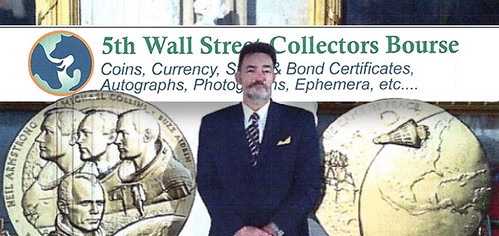
One of the highlights of the 5th Annual Wall Street Collectors Bourse will be a talk by Joel Iskowitz on “Designing Congressional Gold Medals: An Artist’s Perspective”. Mr. Iskowitz will look back on more than three decades creating unparalleled artworks displayed in the Pentagon, the Capitol and the White House. He’s an active United States Air Force artist with oils in the permanent USAF collection.
Twice invited to document space shuttle missions with artwork on permanent display at the Kennedy Space Center Museum, he is the designer of some of our country’s most treasured Congressional Gold Medals–including the New Frontier Gold Medal presented to Apollo 11 astronauts Neil Armstrong, Michael Collins, Buzz Aldrin and Mercury astronaut John Glenn in the Rotunda of the Capitol on November 16, 2011. His first Congressional Gold Medal was designed for the Women’s Air Force Service Pilots of WWII, followed by the Nisei soldiers and the American Fighter Aces–his Congressional Gold Medals total over a dozen.
Published countless times, with his artworks in the permanent collections of the Smithsonian Museum of American History, the Abraham Lincoln Presidential Museum, the New York Historical Society and the Paratroopers Historical Society in France, Mr. Iskowitz has also received the National Oceanic and Philatelic Society citation for his contributions to space philately. His obverse design for the Louis Braille Silver Dollar flew aboard the Space Shuttle Atlantis on its mission to service the Hubble Telescope. And this is the short list of his accomplishments. In his talk he will discuss his progression from being “anonymously famous” to one of America’s most celebrated artists and medallic designers.
When recently asked how coinage and numismatics reflect a country’s culture – political, artistic, and social, he responded:
“Medals are conferred upon highly regarded individuals who accomplish great deeds. Think of the Congressional Medals plus all the coins and medals throughout history. They picture people who are in power, who lay down the laws that any civilization follows and is willing to march and fight for. Our coinage displays qualities like liberty, justice, honor, achievement, the common good. These overarching human concerns are often represented by allegory. But then again you have the historical side that coinage reflects – each and every empire, kings and rulers whose portraits are represented on the coinage. Because the coinage and medals are public art, they’re epic art. They portray the highest ideals and aspirations of a culture. The coinage is emblematic artwork of those precepts. Often it’s done as large public art in sculptures, but it’s just as epic on the small canvas of a Coin. And even more powerful because it has to be reduced to such a small scale and yet carry such an incredibly potent message.
“Coinage is a very interesting entity because it’s art that travels among the populace and there’s no control on how it travels. It’s put out there and goes through the banking system and then the usual flow of currency. And I am honored to put my art on these objects. It fascinates me that my art moves among the people, compared to art that’s in a museum where people go and visit. My art visits the people and there’s no controlling the way it will move around. So it’s really a very vital form of communication. Each coin and medal is a repository of the history of any given culture or era. It’s history and it’s also an ambassador in a way, because it carries a message with a culture’s finest or most moving moments.
“It’s got one other great thing going for it. Buildings, architecture, paintings, sculpture can be destroyed. These little things are amazing survivors. They’ll go down to the bottom of the ocean and stay in pristine shape for 700 years. It seems that every few months another great discovery is made of a Spanish galleon or vessel with ancient coinage. So the coins are incredible repositories of history, great ambassadors with memories of forbearers.”
For more information on the show, see:
www.wallstreetbourse.com
To read the complete article, see:
Coin Designer Joel
Iskowitz at 5th Annual Wall Street Collectors Bourse
(www.coinweek.com/coin-shows/coin-designer-joel-iskowitz-5th-annual-wall-street-collectors-bourse/)
SELECTIONS FROM THE 2015 FALL PAN SHOW AUCTION
Chambersburg & Bedford Turnpike Road Company $10
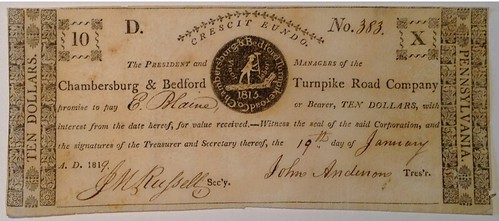
(Bedford, PA)- Chambersburg & Bedford Turnpike Road Company $10 Scrip note dated January 19th, 1819 No.383 It is printed on very thin paper with a few pre-printing paper crinkles. A very small tear at the lower left side of note. There are two very small folds at the lowest left corner that are not visible from the photo.
To view the complete lot description, see:
Chambersburg & Bedford Turnpike Road Company, $10 Pennsylvania Not
(www.coinzip.com/auction/item.php?id=2865)
1921 German White Porcelain Notgeld
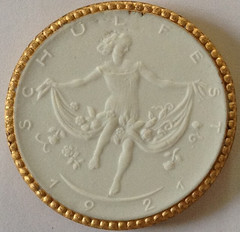
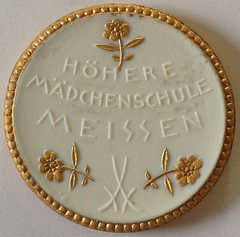
The German porcelain Notgeld are special form of Notgeld between the years 1915 and 1923, in the years before the German Hyperinflation 35mm white porcelain with gold edge and flowers, Hohere Madchenschule, Meissen 1921 Girl and flowers, Schulfest
To view the complete lot description, see:
1921 German White Porcelain Notgeld
(www.coinzip.com/auction/item.php?id=2869)
1916 Swedish Games Plaque
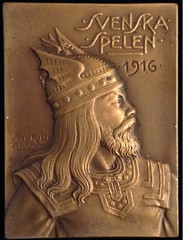
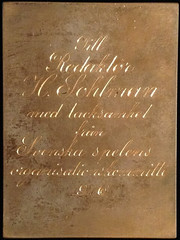
Svenska Spelen (Swedish Games) in Stockholm 1916
Due to cancelled Berlin Games 1916
Sven Kulle
Bronze Plaque
Helmeted Viking
uniface, 41 mm x 55 mm
Beautifully engraved reverse
To view the complete lot description, see:
Svenska Spelen (Swedish Games) in Stockholm 1916 Plaque
(www.coinzip.com/auction/item.php?id=2903)
8 Reales Silver Cob
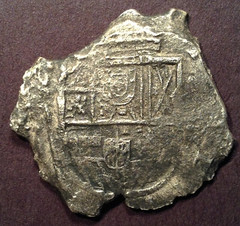
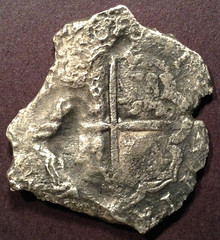
8 Reales Silver Cob
Spain
Date and Assayer off flan.
This cob is from the 1622 wreck of the Sao Jose.
Included is a certificate of Authenticity by Arqueonautas Worldwide.
To view the complete lot description, see:
8 Reales Silver Cob (www.coinzip.com/auction/item.php?id=2926)
Thomas Jefferson original artwork by Joel Iskowitz
Early Numismatist Issues
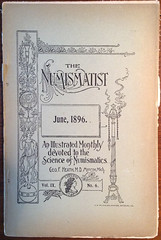
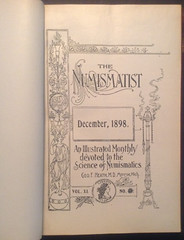
June 1896
Vol. IX No. 6 This original issue includes 2 plates of Condor Tokens, an article featuring Lorin G Parmelee and his acquisition of great
numismatic rarities, a full page ad by the Chapman Brothers, a price list by George Heath, advertising by Ed Frossard, Lyman H. Low This
issue includes all pages, back cover is loose. A very nice piece of numismatic history.
1989
1898 The Numismatist, Leather Bound Year Set
This is a complete early set of Numismatists for the year 1898 292pp 6.25" x 9.25" gilt spine
To view the complete lot descriptions, see:
The Numismatist June, 1896 original
(www.coinzip.com/auction/item.php?id=2872)
1898 The Numismatist, Leather Bound Year Set
(www.coinzip.com/auction/item.php?id=2931)
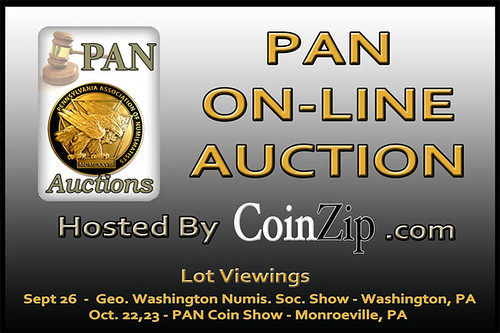
POGUE II: THE RARE COIN MARKET ROARS
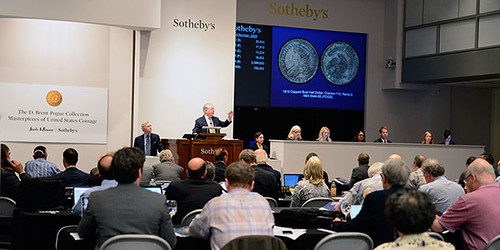
On Wednesday evening, Stack’s Bowers, in a limited partnership with Sotheby’s, offered the second grouping of coins from the D. Brent Pogue family collection.
The second sale featured 105 lots and focused most of its attention on Capped Bust half dollars, Flowing Hair dollars, Capped Bust and Classic Head quarter eagles, and Capped Bust half eagles and eagles.
Headlining the sale was the 1794 “Lord St. Oswald” Flowing Hair dollar (PCGS MS66+), which brought US$4,993,750 after spirited bidding. Laura Sperber of Legend Numismatics was the winning bidder. In addition to the 1794 $1, Pogue’s 1795 “13 Leaves” eagle (PCGS MS66+) cleared the $2 million mark, bringing $2,585,000. Rounding out the second sale’s million dollar coins were the “King Farouk” 1795 “Small Eagle” half eagle (PCGS AU55; $1,175,000) and the “9 Leaves Reverse” 1795 eagle (PCGS MS63+; $1,057,500).
In total, the sale brought $26,120,837.50, which is $808,106.25 more than Pogue I. That sale boasted 128 lots (granted 31 of them were half dimes – and one was a half disme).
At 26+ million, Pogue II exceeded Stack’s Bowers wildest expectations. Pre-sale estimates valued the offerings at between $14.1 million and $20.7 million dollars. At 26+ million, Pogue II bested the high estimate by almost $5.5 million dollars.
After two sales, the Pogue’s have realized $51,433,567.75 for their collection, which Stack’s Bowers estimates to have a value of $250 million.
What is the Pogue Collection?
For those new to numismatics, know that the collection of coins assembled by billionaire Texas real estate moguls D. Brent and Mack Pogue rates as one of the most significant and expensive U.S. coin collections ever assembled.
The majority of the collection spans the first 40 years of U.S. federal coinage, including many of the country’s greatest rarities. In addition to that, many of the coins in the collection are the finest specimens known.
The combination of rarity and quality makes the public offering of these coins significant, not only to individual collectors, for whom this might be the only opportunity in their lives to own these particular coins, but also for the hobby as a whole, as the high profile of the sale transcends numismatics, garnering significant attention in the mainstream press. It’s this type of coverage that helps to legitimize the investment potential of coins and draws new collectors to the “Hobby of Kings”.
But more than that, sales like this are a celebration of the coins themselves. Each coin in the collection has its own story to tell. Q. David Bowers will tell that story in his forthcoming book The D. Brent Pogue Collection of American Coinage: The Definitive Sylloge. Information about Bowers’ “Top 100” can be found in his i>Treasures from the D. Brent Pogue Rare Coin Cabinet (2015).
To read the complete article, see:
Pogue II: Rare Coin Market Roars; a
Look at the Numbers (www.coinweek.com/auctions-news/pogue-ii-rare-coin-market-roars-a-look-at-the-numbers/)
PRINCETON ACQUIRES SCHAAF SASANIAN COINS
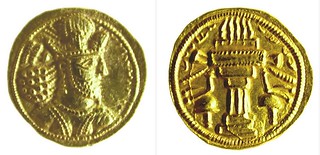 The Princeton University Numismatic Collection has announced the acquisition of one of the most comprehensive collection of Sasanian coins
in private hands, that of Robert W. Schaaf, a New Jersey resident employed in the electronics field.
The Princeton University Numismatic Collection has announced the acquisition of one of the most comprehensive collection of Sasanian coins
in private hands, that of Robert W. Schaaf, a New Jersey resident employed in the electronics field.
For four centuries, the Sasanian Empire was the eastern neighbor of the Roman Empire and for most of the period its adversary. For the most part, Sasanian history is known indirectly through Roman accounts and much later Persian sources; the material culture of the Sasanians, mainly within the modern borders of Iran and Iraq, is very difficult to study. The coinage of the Sasanian Empire, however, preserves a unique documentation of the rulers and minting cities over the centuries, and has the potential of revealing places and periods of relatively high and low monetary activity, which can be interpreted in terms of military and economic phenomena.
In the words of John Haldon, Princeton's Shelby Cullom Davis '30 Professor of European History, and Director of the Mossavar-Rahmani Center for Iran and Persian Gulf Studies, "The Sasanian period of Iranian history is one in which Princeton already commands respect in terms of faculty and research interests, and the acquisition of the Schaaf collection will undoubtedly make a significant contribution both by attracting international scholars and researchers as well as through being a major stimulus to inter-disciplinary and inter-departmental cooperation on campus."
The Schaaf Collection has been purchased for the Princeton University Numismatic Collection with generous support from a gift to the Mossavar-Rahmani Center for Iran and Persian Gulf Studies, and from the Friends of Princeton University Library.
Alan Stahl, Princeton's Curator of Numismatics notes that the 723 gold, silver, and copper coins of the Schaaf Collection were assembled in the course of decades of specialized collecting to include representation of rare mints and short-lived rulers. He remarked, "The new acquisition provides a strong complement to our existing holdings of Roman, Byzantine and Early Islamic coinage to illustrate the transformation of the monetary system of Late Antiquity into that of the Middle Ages, the focus of an extensive research program at Princeton." He added,
"The publication in 2014 of a complete catalogue of the Schaaf Collection by the Austrian Academy of Sciences, written by the leading scholar on the series Nikolaus Schindel, will greatly facilitate the integration of the new coins with the existing Princeton collection of almost 300 coins of the dynasty and the description and illustration of the entire Sasanian collection on our online database."
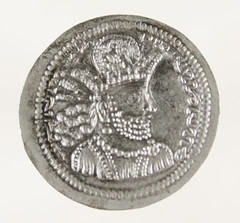
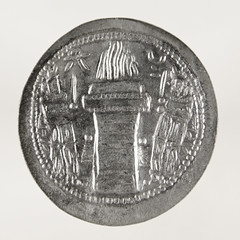
Shapur II, CE 309-379, Ctesiphon Mint Silver drachm (gold dinar above)
The Princeton University Numismatic Collection is part of the Department of Rare Books and Special Collections, Firestone Library. Those parts of the collection already in the database can be accessed from http://rbsc.princeton.edu. Objects in the collection may be viewed by appointment with the curator: astahl@princeton.edu.
HIGHLIGHTS OF PAUL FRANCIS JACQUIER AUCTION 40
October 16, 2015 Paul-Francis Jacquier, Kehl am Rhein
Auction 40 – Ancient Coins and Art
For Advanced Collectors: Jacquier Auction 40
Aficionados looking for numismatic rarities certainly know auction house Paul-Francis Jacquier. Once again, his 40th catalog offers extraordinary items featuring perfect bronzes dating from Roman Imperial Times as well as a number of rare quinarii.
920 lots will come under the hammer at Auction 40 of Paul Francis Jacquier. That makes 920 opportunities for the collector to enrich his collection by rarities and exclusive pieces on October 16, 2015, starting at 4 pm. After all, the Kehl am Rhein-based auction house is specialized in numismatic rarities. This auction, therefore, features specimens that are rarely encountered on the market.


((4 – Celts. Eburones (Gallia Belgica). Electrum stater, after 54 BC. LT 8859. Very rare. Extremely fine. Estimate: 2,000 euros.))
The sale starts with roughly 70 Celtic coins. The connoisseur not only discovers such widely known rarities as a perfect rainbow cup of the Eburones tribe (estimate: 2,000 euros) or a very fine and very rare electrum stater of the Helvetii (estimate: 3,000 euros), but also a number of büschelquinarii and other silver fractions of the Vindelici tribe, who once lived around Manching and Augsburg. The appraisals range between 60 euros and 150 euros. The coins are dated and described precisely based on the latest numismatic literature.
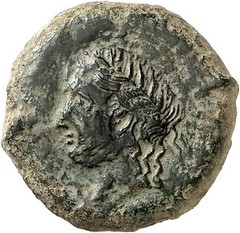
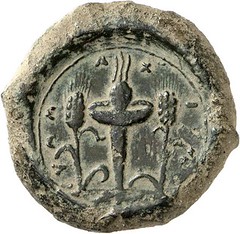
((83 – Greeks. Alaisa (Sicily). Symmachy coinage, hemilitron, ca. 332-317. CNS II, 446-447, 14-14/5. Very rare. Very fine / extremely fine. Estimate: 850 euros.))
Nearly 100 lots of coins from the Greek world are next. When turning to bronze, the collector will find much interesting material, like a hemilitron of the Greek city of Alaisia displaying a wonderful olive-green patina (estimate: 850 euros).
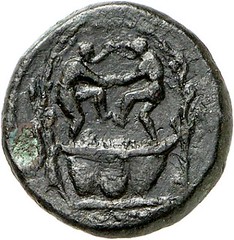
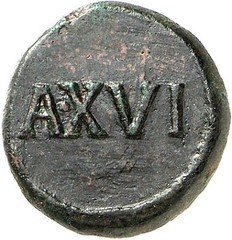
((199 – Roman Imperial Times. Tessera, ca. 22-37. Two bearded men stomp grapes in a winepress. Cohen VIII, 266, 8. Buttrey -. Unique subject and very rare. Fine dark brown patina, good very fine. Estimate: 1,500 euros.))
The catalog’s main part is dedicated to the Romans, from the coinage of the imperatores to the Late Roman period. The connoisseur will be amazed to see such great a number of extraordinary specimens assembled. Let’s start with the coins dating from the 1st century, supplemented by a small selection of tesserae and jetons.
One of the specimens whose obverse depicts two men stomping grapes makes it possible to rectify a misreading by Cohen: he mistook his poorly preserved comparative pieces for a representation of two boys playing in a bathtub.
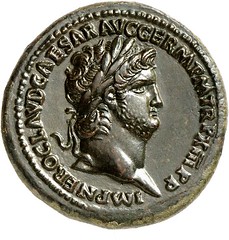
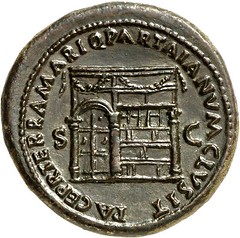
((209 – Nero, 54-68. Sestertius, 67. RIC 354. Shining black brown patina. Extremely fine specimen. Estimate: 15,000 euros.))
Another highlight is a collection of perfect bronze coins of the finest style. A truly remarkable piece is a sestertius of Nero struck in 67, with a depiction of the Temple of Janus on the reverse. This coin refers to Nero’s biggest success in foreign policy: he managed to negotiate a truce with the Parthians, and an envoy of the Parthians came to Rome to seal the deal on peace in an ostentatious ceremony. This ceremony included the closing of the Temple of Janus, an event which was commemorated on a series of aurei, denarii and bronze coins. With their sheer size, the bronzes are impressive representatives of this relatively unknown Neronian coinage.
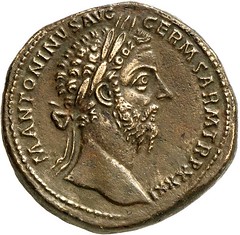
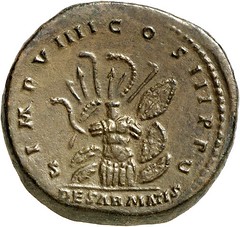
((248 – Marcus Aurelius, 161-180. Sestertius, 177. RIC 1190. Beautiful gold brown patina. Extremely fine. Estimate: 3,000 euros.))
But the auction offers many more examples of these magnificent bronze coins. We would like to highlight a sestertius of Agrippina Maior with a portrait which is shown in full detail (estimate: 15,000 euros), a sestertius of Domitianus with a shining black green patina (estimate: 4,000 euros), and an appealing sestertius of Marcus Aurelius depicting a heap of Germanic-Sarmatian weapons on the reverse, reminiscent of a victory over the Sarmatians (estimate: 3,000 euros).
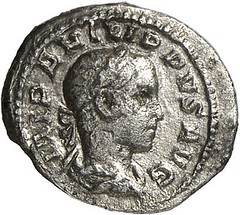

((317 – Philippus II, Augustus 247-249. Quinarius, Rome, 248. RIC 231b. King 369, 6. 3rd specimen known to exist! Very fine / extremely fine. Estimate: 5,000 euros.))
Another highlight of the Roman section is a collection of quinarii, including some particularly rare specimens, ranging in date from Trajan’s reign to the Tetrarchic Period. The specialized collector discovers, among other items, a quinarius of Julia Mamaea (estimate: 1,200 euros), another quinarius of Philippus II (estimate: 5,000 euros), one of Diocletian (estimate: 650 euros), and lastly, a quinarius of Maximianus Herculius (estimate: 3,000 euros).
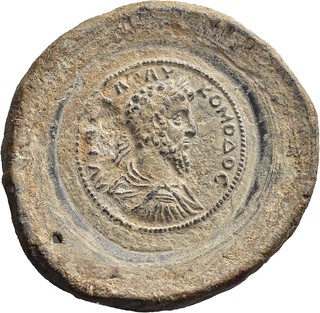
((261 – Commodus, 180-192. Lead medallion (die pattern?). Very rare. Fine lightish lead patina. Extremely fine. Estimate: 1,250 euros))
Gold, silver, bronze – in this auction the coin aficionado will be offered every metal used in Roman times for the minting of coins, to which adds a lead medallion of Commodus, bearing a Greek inscription, that might have been produced as die pattern (estimate: 1,250 euros).
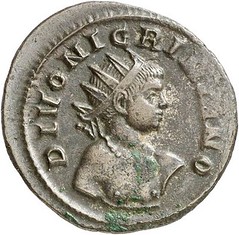
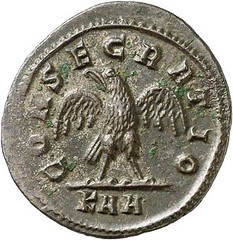
((443 – Nigrinianus, son of Carinus, +284. Antoninianus, Rome, autumn of 284. RIC 472. Very rare. Fine patina with a metallic color. Nearly extremely fine. Estimate: 2,500 euros))
Everybody familiar with the house Jacquier knows perfectly well with how much expertise the specimens are being assembled, notably the rarities from the reign of the barrack emperors. An almost flawless aureus of Gallienus from the Archer M. Huntington Collection, which shows a depiction of Laetitia on the reverse (estimate: 10,000 euros) might become the most expensive item of this period. Nevertheless, the real stars are the hidden rarities. To name just a few: a number of legionary coins of Gallienus, some really extremely rare coins of Postumus, of which 30 lots will cross the auction block, the antoniniani featuring special busts and unusual legends, and, last but not least, such remarkably well-preserved rarities like an antoninianus which Carinus had issued for his deceased son Nigrinianus (estimate: 2,500 euros).
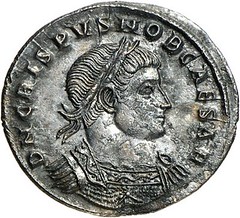
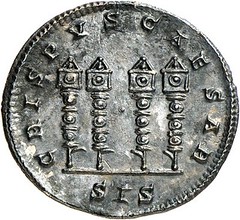
((528 – Crispus, +326. Miliarense, Siscia, early in 326(?). D N CRISPVS NOB CAES Armored, laureate bust in frontal view, right. Rev. CRISPVS CAESAR / SIS Four standards standing on groundline. C -. RIC -. Cf. RIC 449, 198 (Constantinus I) and 199 (Constantius II. Caesar). 4.10 g. Unedited, unique. Fine tin-colored toning. Extremely fine specimen. Estimate: 25,000 euros)) Having arrived at the Tetrarchic Period and the imperial house of Constantine, we would like to stress that this section comprises not only several items of interest, but also an outright numismatic sensation that is an asset likewise to numismatics as an academic discipline: an unedited unique example of a miliarense of Crispus from Siscia, that has probably been minted early in 326 (estimate: 25,000 euros).
This “missing link” provides a date for two known miliarenses of the very same reverse type for Constantine and Constantius II against the backdrop that Crispus, by order of his father, was executed in Pola / Istria in the spring of 326. Therefore, the entire emission, to which almost certainly a miliarense for Constantine II has to be added, dates to the few months prior to Crispus’ execution.
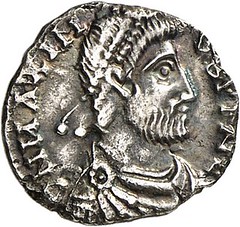
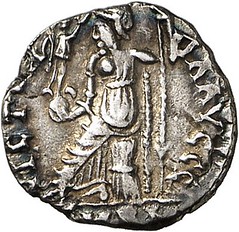
((556 – Maximus, usurper in the West 409-411. Siliqua, Barcino (Barcelona), 410-411. RIC 1601. Ex Crédit de la Bourse Auction, Paris, April 19, 1995, lot 672, and Jacquier 23 (1999), 764. Very rare. Slightly toned. Nearly extremely fine. Estimate: 3,500 euros.))
Some coins from Late Roman Times, like an almost extremely fine siliqua of Maximus, issued in Barcelona in 410-411 (estimate: 3,500 euros), and a number of coins of the Crusader states conclude this section.
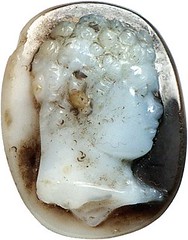
((595 – Cameo, layered agate, white on grey, horizontally oval, 1.8x1.4x06 cm. Bust of juvenile Hercules (?) or Caracalla(?), lion skin(?) around neck. Late 2nd / early 3rd cent. AD. Estimate: 1,450 euros.))
The department of ancient art follows next. It comprises a rich assemblage of gems, a small selection of fibulae in different shapes, a number of spoons and toilet utensils, and, most notably, an interesting series of Hallstatt culture weapons and tools.
As always, the catalog ends with an exquisite offer of books, providing quite a few collectors and coin dealers with the opportunity to enrich their private libraries. Or do you call the comprehensive, three volume work on Sicilian bronze coinage by author Calciati (estimate: 1,000 euros) already your own? Last but not least, we would like to emphasize that a considerable number of modern auction sale catalogs are likewise being offered for sale. These catalogs make a valuable standard reference for every collector.
The lavishly illustrated catalog may be ordered for a nominal charge of 12.50 euros at Paul-Francis Jacquier, 77694 Kehl am Rhein, Honsellstrasse 8, telephone: +49 (0)7851 / 1217, email: office@coinsjacquier.com
Please register in time for live bidding on the internet at www.coinsjacquier.com
Please find the auction catalog online at http://www.sixbid.com/browse.html?auction=2249
THE BOOK BAZARRE
HIGHLIGHTS OF GADOURY NOVEMBER 2015 AUCTION
November 14th, 2015
Monaco, Éditions V. Gadoury
Vente aux Enchères de Monnaies de Prestige
Exquisite Collection of Savoy Coins
The upcoming Gadoury sale will present a large collection of coins of Savoy featuring many great rarities. The connoisseur will furthermore find coins ranging in date from antiquity to the present time. The auction will focus on France, Russia, and, needless to add, on Monaco – not to forget the rich material from Islamic countries, such as Egypt or Iran.
You need to remember a new date for the Gadoury sale in Monaco. The auction will no longer be in early December but in mid-November. So, the 5th auction sale of Éditions V. Gadoury has been scheduled for November 14th, 2015. The coin show, which always takes place the day after the auction, was likewise antedated, to November 15th, 2015. Coming to Monaco will thus pay off, to attend both the auction sale and the coin show, not to forget a fabulous exhibition: From November 14 to November 15, there will an exposition titled “Le Roi-Soleil et les Princes de Monaco” (= The Sun King and the Princes of Monaco) featuring many a rarity never seen before at the Musée des Timbres et des Monnaies.
And if you are preferring buying coins to looking at them, Gadoury will present a broad array of numismatic items in his 5th auction. It leads the coin collector all the way from antiquity to the present age. This catalog lists many special collections composed of items you will seldom see.
The emphasis of the ancient coins is on the numismatic output of the Roman Empire. There, a large number of rare aurei can be found – both, of the finest grades possible and of grades allowing the “normal” collector to bid on the items he desires without over-checking his account. An example is the rare aureus of Trajan featuring the Forum Traiani on its reverse. The specimen is graded very fine, nevertheless, every small detail of the depiction is clearly recognizable (5,000 euros). The aureus of Lucius Verus, on the other hand, is extremely fine and depicts the installation of the Armenian King on the reverse (6,000 euros). Rare denarii of extremely fine quality and fine bronze coins with untouched patina will cross the auction block, too.
The late antique coinages are impressive with all the rarities, including a solidus of Marjorian graded nearly extremely fine (10,000 euros), an extremely fine solidus of Libius Severus (5,000 euros), and a very fine half siliqua of Julius Nepos (4,000 euros).
A few Byzantine and Celtic coins follow. We would like to highlight a solidus of Justinian II, struck either in Naples or in Ravenna (5,000 euros). The ancient coins on offer are concluded by coinages from the Migration Period, including rare specimens form the Lombard Empire.
At Gadoury’s, the world coins always start with Monaco. And of course the Monegasque auction house is able to present many a rarity. To name only two: a 1653 écu of Honoré II (2,500 euros) and a 1673 écu of Louis I (3,000 euros). Likewise interesting are the medals and plaques that bear testimony to, among others, the automobilists’ attraction for Monaco. Special mentioning deserve the large number of essays and pieforts, including an assortment, still in the original packaging, consisting of 8 pieforts and 8 essays dating from 1950 in both gold and silver (7,000 euros).
Turning to the rest of the world, the lots on offer cover the entire geographical range, from ‘A’ as in Afghanistan to ‘Z’ as in Zaire. Anyone looking for the special and the extraordinary will find many items to his or her liking, as the sale comprises many specimens that are hard to come by. And by this, we do not only refer to the Chinese 1990 20 ounce piece that depicts the Great Wall of China on the obverse and the dragon and phoenix motif on the reverse, of which only 250 specimens were struck (35,000 euros). This likewise goes for a collection of Egyptian gold coins, spanning the chronological spectrum from the Mamluk Period to the present time.
Gadoury is a known specialist for French coins, as the famous red book is written in-house. Some of the material listed there as R(4) or R(5) is currently on offer at Gadoury’s Auction 5. Chronologically, the spectrum ranges from the Carolingians, the Middle Ages and the Bourbons, to the era of the French Revolution and modern times. Please note the following main fields: A collection of coins of Louis XIV with many rare mints and dates, a small series of specimens from the era of the Constitutional Monarchy (1791-1793), and a large collection of coins issued by Napoleon I, likewise featuring rare mints and rare dates. Napoleon I is going to reappear, when we turn to Italy. Here, an interesting series of coins issued by Napoleon in Italy can be found. This series includes notable rarities, such as a 40 francs piece, of which no more than 346 specimens were struck in Turin in 1808 (10,000 euros). But let’s return to France. We have to mention the rare patterns and pieforts of 20th-century circulating coins. Here you will spot one of the rarest coins from the 5th Republic, a pattern for the 1959 2 franc gold coin with the depiction of the female seeder. The French session will be concluded by a broad array of coins from the French colonies.
After a small selection of gold coins from Iran, Italy – as was said above, beginning with a number of coins issued by Napoleon – will follow featuring many more interesting items. A large special collection is devoted to the Duchy of Savoy, the Kingdom of Sardinia and the Italian royal house, the specimens on offer ranging in date from the 14th to the 20th century. Highlights are a 80 lire piece of Vittorio Emanuele I, of which 965 specimens were minted in Turin in 1821 (25,000 euros), a 20 lire piece from both the same year and the same mint, the rare variant exhibiting a dot following the lettering PRINC on the coin‘s reverse (20,000 euros), as well as a 1872 100 lire piece of Vittorio Emanuele II from Rome, of which 661 examples were struck (18,000 euros), another one from 1878, with the even smaller mintage of 294 specimens (35,000 euros), and, lastly, a 100 lire piece of Umberto I, of which no more than 180 specimens were issued in Rome in 1880 (20,000 euros). A couple of rare coins of Vittorio Emanuele III will likewise come under the hammer, such as a 1903 100 lire piece, of which 966 specimens were struck (18,000 euros), and a 1950 100 lire piece with a total mintage of 1,012 examples (10,000 euros).
There is more to come. The Russian section features several very interesting items, a part of which constitutes a gold medal, awarded by Grand Duke Mikhail Mikhailovich to his carriage driver in 1911. Grand Duke Mikhail, though great uncle of Nicholas II and thus closely related to the Tsaristic family, had nevertheless to go into exile to Southern France for he was married morganatically to Sophie of Merenberg. Ultimately, however, that saved his life because he did not fall victim to the revolution. Gadoury now presents a gold medal that is closely linked to this interesting figure of Russian history. Depicting the portrait of Nicholas II, it was nevertheless Grand Duke Mikhail who awarded this medal to his carriage driver. This is corroborated by a letter addressed to the driver written by the Grand Duke’s own hand (5,000 euros).
Finally, as the last of the larger collections that will be called out at this auction, a series of US American gold coins, all of which are graded by PCGS, will conclude the sale.
You may order the catalog at Éditions Victor Gadoury, 57, rue Grimaldi, 98000 Monaco; phone: +377 93 25 12 96; telefax: +377 93 50 13 39; email: contact@gadoury.com.
The catalog is likewise available on the internet at www.gadoury.com, www.sixbid.com, and www.numisbids.com. Naturally, live bidding from your computer at home is also available.
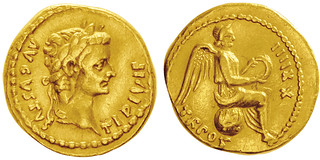
Lot 22: TIBERIUS, 14-37. Quinarius, Lyon, 22-23. RIC 8. Ex Ratto Auction 1934, 378. Nearly extremely fine Estimate: 5,000,- euros
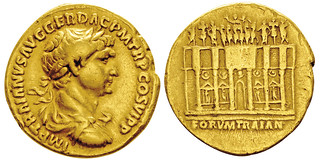
Lot 45: TRAIANUS, 98-117. Aureus, Rome, 112-114. RIC 257. Rare. Good very fine Estimate: 5,000,- euros

Lot 63: LUCIUS VERUS, 161-169. Aureus, Rome, 163-164. RIC 512. Rare. Extremely fine Estimate: 6,000,- euros
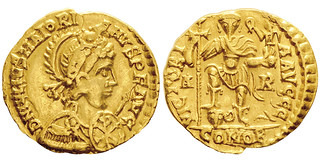
Lot 93: MAIORIANUS, 457-461. Solidus, Arles, 458-461. RIC 2631. Extremely rare. Nearly extremely fine Estimate: 10,000,- euros

Lot 95: JULIUS NEPOS, 474-475. 1/2 siliqua, Ravenna, 474-475. RIC 3216. Extremely rare. Good very fine Estimate: 4,000,- euros
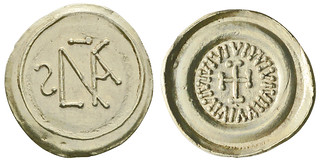
Lot 123: LANGOBARDS. Tremissis, Lucca, 7th-8th cent. This variant unedited. FDC Estimate: 5,000,- euros
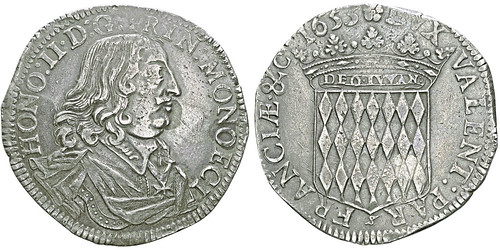
Lot 124: MONACO. Honoré II, 1604-1662. Écu 1653. Gadoury MC30. Good very fine / extremely fine Estimate: 2,500,- euros

Lot 140: MONACO. Plaque “Semaine Automobile de Monaco” from March 1922 by Lallemand and Huques. Extremely fine Estimate: 300,- euros

Lot 170: GERMANY. Wuettemberg. Frederick William. 1824 gold medal of 20 ducats by G. Voigt. Rare. Extremely fine Estimate: 3,000,- euros
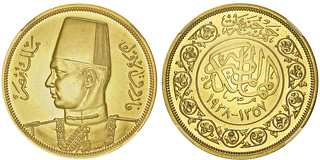
Lot 245: EGYPT. Farouk, 1936-1952. 500 piaster 1357 AH (= 1938). Graded NGC PF62. Proof Estimate: 3,000,- euros
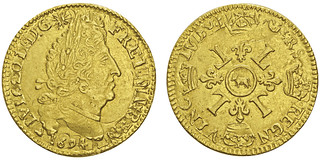
Lot 324: FRANCE. Louis XIV, 1643-1715. Louis d’or de Béarn aux 4 L, réformation, Pau, 1694. Gadoury 252a (R5). Extremely rare. Extremely fine Estimate: 2,000,- euros
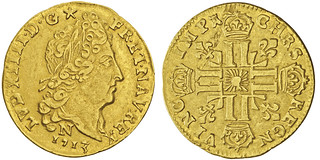
Lot 330: FRANCE. Louis XIV, 1643-1715. Demi-louis d’or aux soleil, flan neuf, Montpellier, 1713 N. Gadoury 243 (R5). Extremely rare. Extremely fine Estimate: 1,500,- euros
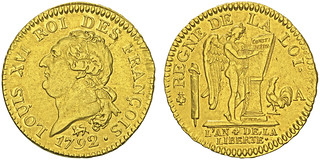
Lot 349: FRANCE. Constitutional Monarchy, 1791-1793. 24 livres, Paris, 1792, 2e sem. Gadoury 61. Extremely fine Estimate: 8,000,- euros
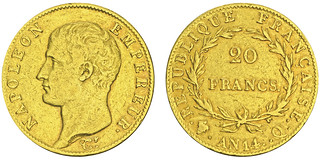
Lot 359: FRANCE. Napoleon I. 20 francs, Perpignan, AN14Q. Gadoury 1022. Only 2,710 specimens struck. Good very fine Estimate: 5,000,- euros
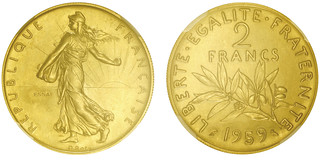
Lot 450: FRANCE. 5th Republic, 1959-present. Gold pattern for 1959 2 francs seeder. Only 4 specimens struck! Graded NGC MS64 Estimate: 15,000,- euros
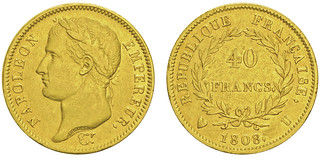
Lot 535: ITALY. Subalpine Republic. Napoleon. 1808 40 Francs, Turin. Gadoury 1083. Only 346 specimens struck. Nearly extremely fine Estimate: 10,000,- euros

Lot 606: ITALY. Parma. Odoardo Farnese, 1622-1646. 2 doppie, Parma, 1624. Unedited. Good very fine / extremely fine Estimate: 15,000,- euros
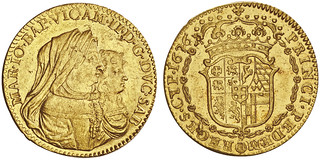
Lot 664: ITALY. Savoy. Vittorio Amedeo II, 1675-1730. Doppia, Turin, 1676. CNI 3/35. Very rare. Extremely fine Estimate: 4,000,- euros
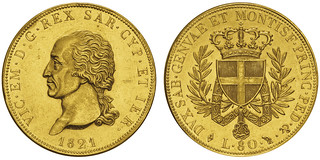
Lot 672: ITALY. Sardinia. Vittorio Emanuele I, 1802-1821. 80 lire, Turin, 1821. MIR 1027a. Only 965 specimens struck. Extremely fine Estimate: 25,000,- euros
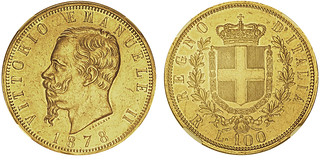
Lot 695: ITALY. Vittorio Emanuele II, 1861-1878. 100 lire, Rome, 1871R. MIR 1076c. Only 661 specimens struck. Graded NGC AU58 Estimate: 18,000,- euros

Lot 706: ITALY. Vittorio Emanuele III, 1900-1943. 100 lire, Rome, 1903 R. MIR 1114c. Only 966 specimens struck. Graded NGC MS61 Estimate: 18,000,- euros
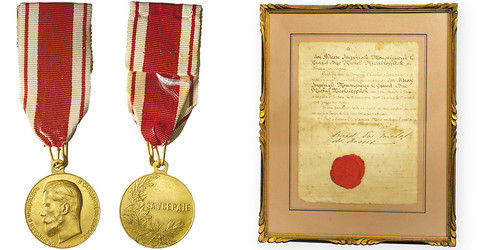
Lot 769: RUSSIA. Nicholas II, 1894-1917. Decoration with gold medal, awarded with letter written by Grand Duke Mikhail Mikhailovich for his carriage driver. Unique in this assortment. Extremely fine Estimate: 5,000,- euros
MORE ON THE J. L. BERCH COUNTERSTAMP
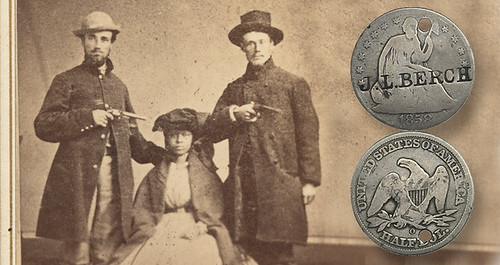
Jeff Starck of Coin World writes:
A while back, we discussed the “Civil War dog tag” in Steven Davis Numismatic Auctions LLC’s auction. I was going to write a blog but instead wrote a full story about the research that went into determining that it wasn’t a Civil War ‘dog tag.’
If Hollywood had written the script, a highlight from Numismatic Auctions LLC’s summer auction would have turned out to be a Civil War “dog tag.”
But, Coin World is in Ohio, and the auction firm is in Michigan, and Hollywood is thousands of miles away from both of those states.
As a collector and writer, I cling to the pieces that tell an amazing story.
A most common idle thought among collectors is to wonder who held the coins that they now own. Where did this coin travel? What did it buy? Was it lost, to the dismay of the owner, or was it collected and protected with care, a special token of an event in life or death?
But sometimes stories are not to be as fantastic as you wish them to be.
That was the case with an 1858-O Seated Liberty half dollar in the aforementioned auction.
The briefest of lot description teased for further exploration.
The holed coin bears the name J.L. Berch across the obverse. According to cataloger Steve Davis, the host coin is toned but in Very Good condition, while the countermark is Extremely Fine.
The only other line about the lot was pregnant with possibility.
“A little research might yield the background of Berch,” it read.
In search of a fantastic story, I began digging.
Davis said the item was “a real beater, [found] at the bottom of the box of Civil War jewelry. It looks legit but I’m going to let the researchers sort it out.”
Examples of coins that served in a military capacity as a Civil War “dog tag” are real but extremely scarce and often misrepresented.
I was surprised that a New Orleans Mint struck coin would be associated with a Northerner. We know that, in general, circulation patterns suggest coins circulate predominantly nearest to the Mint that struck them.
It sure has been true for the 20th century but was even more so when the country wasn’t hyperconnected as it is today.
Could this item really have served as a “dog tag” for a Civil War soldier? What a story that would be! An artifact of the pivotal American conflict, traced to the soldier who owned it!
I reached out to Nancy Dearing Rossbacher, editor of North South Trader’s Civil War Magazine, and author of a treatise about the abundance of questionable pieces that flood the market.
She confirmed that there was a Civil War soldier (a quartermaster) by the name of Jesse L. Berch, the only name to match the countermarked name in all three initials.
My pulse quickened.
A quick search of the soldier’s name revealed a listing at the Library of Congress website.
Jesse L. Berch and a fellow soldier were involved in a rescue of at least one slave.
The 22nd Wisconsin was known as the Abolition Regiment, according to Julia Pferdehirt in Freedom Train North: Stories of the Underground Railroad in Wisconsin.
According to Pferdehirt, Berch and Corp. Frank Rockwell escorted a “soldier boy” (who was actually a female slave) some 100 miles to freedom, to famed abolitionists Levi and Catherine Coffin in Cincinnati.
According to research shared by Rossbacher, Berch died in Jackson, Mich., in 1887, in his late 40s, and is buried in Racine, Wis., his hometown.
Was there any special meaning to the date of the coin?
Rossbacher wrote: “Out of curiosity I checked to see if 1858 had significance to him, but didn’t immediately see a bingo. He was married in ’61, and all of his known children’s births postdated that. Looks like both parents outlived him, so it’s not that.”
Davis confirmed that the estate in which the coin was found was within 20 miles of Jackson, Mich. It had been in the same family for some 90 years, after being acquired by a family member.
While nothing so far conclusively proves that the piece was once owned by Jesse L. Berch of the Abolition Regiment, research indicates a very strong likelihood.
But it’s not a ‘dog tag’
But what is it? How should it be classified?
To read the complete article, see:
Research can change a coin’s value and
enrich one's knowledge of history (www.coinworld.com/news/us-coins/2015/09/research-can-change-a-coins-value.html)
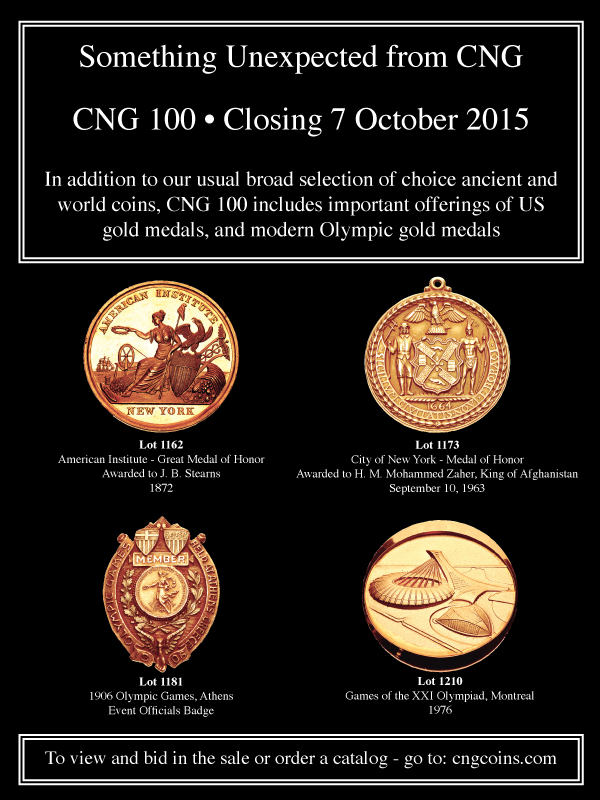
THE MEDALS OF ALEX SHAGIN
Alex Shagin was born near Leningrad, Soviet Union (now Saint Petersburg, Russia) in 1947. He graduated from the Vera Mukhina School of Arts and Design in Leningrad in 1972, and then designed commemorative coins and medals for the Leningrad Mint, including popular medals for the Apollo-Soyuz space ventures and for the Moscow Olympics – these are but a few of his designs. He immigrated to the United States in 1980, and since then has worked as a freelance medallic artist in Southern California. He was the 1995 recipient of the J. Sanford Saltus Award for Signal Achievement in the Art of the Medal from the American Numismatic Society. Most of the pieces offered here are cast by the artist and signed and numbered by hand-engraving.
Shagin’s medals are seldom seen in the marketplace. We expect that published “mintage” statistics reflect the original advertising and nothing more, with examples cast a few at a time, as orders came in. Many Shagin creations are probably still in the collections of those who bought them at issuance, accounting for their rarity. The nine cast pieces below comprise 2-3 times as many Shagins as I’ve had in the previous 30 years. For more on Alex Shagin see the Wikipedia article on him and Donald Scarinci’s discussion of his work at a recent FIDEM Congress.
1984 George Orwell, English writer, a political god to conservatives, with their belief in the worth of the individual. Bronze, 78mm, #20 of an edition of 84(!). $165.
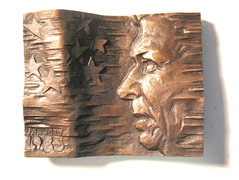
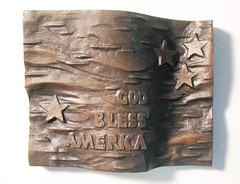
1985 Ronald Reagan, second inauguration, cast bronze, curved surface, 106 x 85 mm. FREE-STANDING and HUGE. A political god to FAKE CONSERVATIVES, who laud the individual and slam the government, but who always side with the government against the people, collectively and individually. This should probably be $225, but I just can’t get myself to price Reagan higher than Orwell. $165
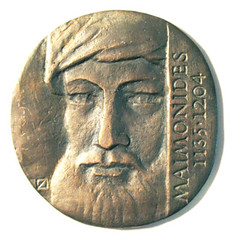
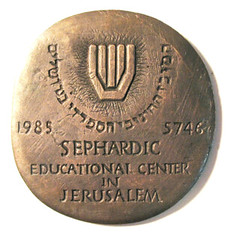
1985 Maimonides, medieval Spanish-Egyptian Philosopher and Jewish Theologian, for the Sephardic Educational Center in Jerusalem, cast silver, 149.4 gr., 75 x 79 mm. $395.

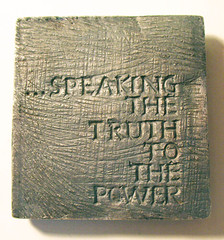
1987 Elie Wiesel, Holocaust Survivor and Nobel Laureate, cast sterling silver, 350.5 gr., 66 x 69 mm. Both the portrait and the words (“SPEAKING THE TRUTH TO THE POWER”) are….powerful! $495.
To read the complete article, see:
Medals of Alex Shagin (www.pauljbosco.com/shagin.htm)
ALEXANDER KIRKWOOD & CO, MEDALLISTS
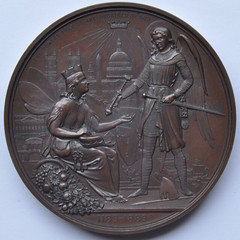 Regarding the earlier article about the 1889 Mayoralty of London medal by A. Kirkwood & Son, Philip Mernick writes:
Regarding the earlier article about the 1889 Mayoralty of London medal by A. Kirkwood & Son, Philip Mernick writes:
I was amazed to find that Alexander Kirkwood & Co, founded in 1826, are still active as medallists. I asked them if they knew the engraver and got this reply almost instantly. Their longevity might be a useful start of another E-Sylum string about the earliest established but still operating, medallists.
Thank you for your enquiry
We produced the dies and struck the medals for the 700th Anniversary. According to my father, we took part in a supply and design competition and won the order. I think the dies and medals, not to mention the medal cases are the finest example of all the medals we have ever produced.
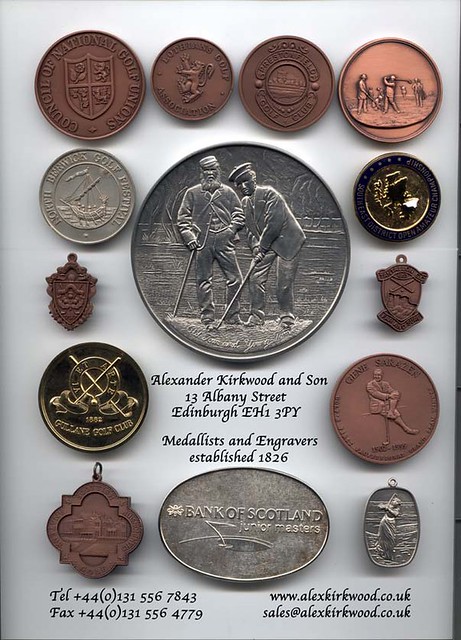
To visit the Kirkwood web site, see:
http://www.alexkirkwood.co.uk/
To read the earlier E-Sylum articles, see:
SELECTIONS FROM THE RICHARD COOPER COLLECTION SALE
(www.coinbooks.org/esylum_v18n37a32.html)
NOTES FROM E-SYLUM READERS: SEPTEMBER 27, 2015 : More on the Mayoralty of London
Medal (www.coinbooks.org/esylum_v18n39a12.html)

HIGHLIGHTS FROM THE NEWMAN PART VII SALE
Eric P. Newman, author of the indispensable reference work, The Early Paper Money of America has been collecting and researching paper currency for over 75 years. Newman Part VII, the second in a series of currency sales, includes rare and historically significant World, Colonial, Continental, Obsolete and Confederate currency that has been off the market for decades. Highlights from the Signature session appear below.
Items being sold are from the extensive collection of Eric P. Newman Numismatic Education Society (a Missouri not-for-profit corporation) and have been assembled over a period of 90 years. Proceeds of the sale of all items will be used exclusively for supplementing the Society’s museum operations and scholarly numismatic research efforts and for the benefit of other not-for-profit institutions selected by Eric P. Newman Numismatic Education Society for public benefit.
Lot 18013: Great Britain - Bank of England £200 June 20, 1918
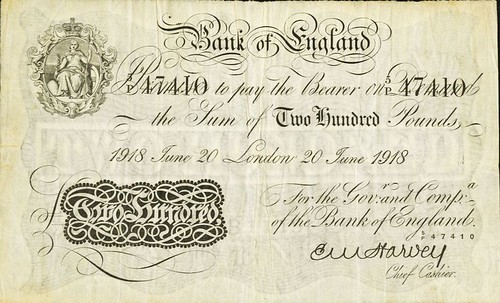
Exceedingly Rare Final £200 London "White Note"
Great Britain - Bank of England £200 June 20, 1918 Pick 317, B209f. PCGS Fine 15PPQ.
This is an exceedingly rare and important Bank of England note. London 1918 high-denomination "White Notes" are particularly rare. The £200 denomination was discontinued on June 20th of 1918, the same date as engraved on this note. Pam West lists it simply as "Rare" and without prices in English Paper Money. Newman acquired this note in the early 1990s from the grandchildren of a Russian banker who felt it would be confiscated if redeemed amidst the instability of the Russian Revolution. At the time, Newman's research pointed to it being the only example of the denomination known, but another example is pictured in West's book. It remains one of the most elusive "White Notes" for collectors and in comparison, the £1,000 denomination, which is also listed as "Rare," has not been offered at auction since 1996. It has the standard Bank of England design with Britannia at upper left. The denomination guilloche is at left, outlined TWO HUNDRED in script. At bottom is the engraved signature of Ernest Harvey, Chief Cashier.
To read the complete lot description, see:
Great Britain - Bank of England £200 June 20, 1918 Pick 317, B209f.
(http://currency.ha.com/itm/world-currency/great-britain-bank-of-england-200-june-20-1918-pick-317-b209f-pcgs-fine-15ppq/a/3539-18013.s?ic4=ListView-ShortDescription-071515)
Lot 18113: Province of New Hampshire May 1, 1761 10 Shillings
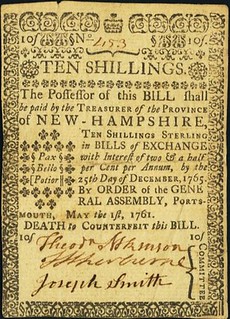
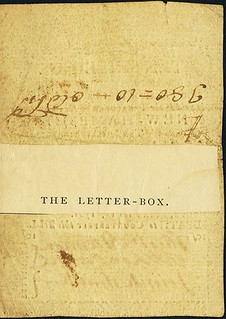
Bold and Likely Unique May 1, 1761 10 Shillings
Province of New Hampshire May 1, 1761 10 Shillings Fr. NH-114. PCGS Extremely Fine 40 Apparent.
This is an extraordinary New Hampshire Colonial note and the only example from the series we have seen or are aware of. Like the January 1, 1761 six pence offered here, this is the Newman 5th edition plate note. A larger bill than the six pence, with intricate ornamental patterns on the perimeter, a small crown at the top center, and the texts enclosed within. The small cartouche at the left center encloses the motto PAX BELLO POTIOR. The notes were payable by December 25, 1765 in 2.5% interest bearing Bills of Exchange. From the face, this has the appearance of a nearly "as made" note. Beautifully printed and mostly well margined.
To read the complete lot description, see:
Province of New Hampshire May 1, 1761 10 Shillings Fr. NH-114.
(http://currency.ha.com/itm/colonial-notes/province-of-new-hampshire-may-1-1761-10-shillings-fr-nh-114-pcgs-extremely-fine-40-apparent/a/3539-18113.s?ic4=ListView-ShortDescription-071515)
Lot 18248: Continental Currency April 11, 1778 $5 Yorktown Issue
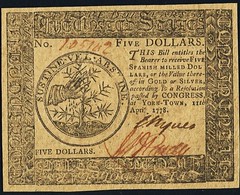
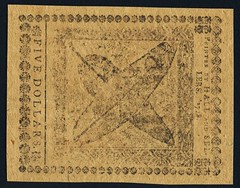
Superb Gem New 67PPQ Yorktown $5 Note
Continental Currency April 11, 1778 $5 Yorktown Issue Fr. CC-72. PCGS Superb Gem New 67PPQ.
The April 11, 1778 Resolution "at York-town" series is the rarest overall in the Continental Currency genre. This is the first of an exceptional quintet of Yorktown note denominations from the Newman collection. Several are the finest, or tied for the finest, graded and certified by PCGS. This $5 Yorktown is a stellar example with inspiring eye appeal. Interestingly, there are only two Uncirculated notes graded by PCGS. Both, including this example, are Superb Gem New 67PPQ. Very bold printing and wide, even margins are on both sides, and face-to-back registration is perfect.
To read the complete lot description, see:
Continental Currency April 11, 1778 $5 Yorktown Issue Fr. CC-72.
(http://currency.ha.com/itm/colonial-notes/continental-currency-april-11-1778-5-yorktown-issue-fr-cc-72-pcgs-superb-gem-new-67ppq/a/3539-18248.s?ic4=ListView-ShortDescription-071515)
Lot 18479: Brownville, NE - Nemaha Valley Bank $1

Brownville, NE - Nemaha Valley Bank $1 Oct. 1, 1859 NE-10 G4a. Remainder. PCGS Very Fine 25.
This is from the rare series of notes engraved and printed by Wellstood, Hay & Whiting. The notes printed by Toppan, Carpenter & Co. are readily encountered. The style is exceptional, and this has an unusual red color "Lazy 1" at the top center. The theme of progress is illustrated by the contrast (and similarities) of the farmers at left and the Native Americans at right. It is interesting that both couples were depicted with their dogs. An oval portrait of a woman wearing a hair ornament is at the base. This is an impeccably styled Territory of Nebraska type. Signed, but we believe falsely.
To read the complete lot description, see:
Brownville, NE - Nemaha Valley Bank $1 Oct. 1, 1859 NE-10 G4a. Remainder.
(http://currency.ha.com/itm/obsolete-banknotes/brownville-ne-nemaha-valley-bank-1-oct-1-1859-ne-10-g4a-remainder-pcgs-very-fine-25/a/3539-18479.s?ic4=ListView-ShortDescription-071515)
Lot 18539: Boggy Depot, (Choctaw Nation, I. T., Western Arkansas)
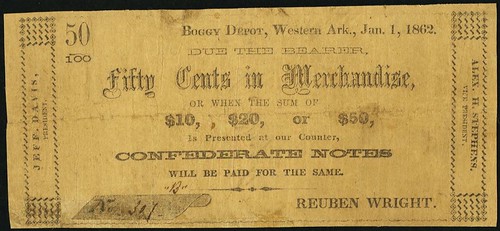
Unique and Historically Important Boggy Depot, Western Arkansas Note
Boggy Depot, (Choctaw Nation, I. T., Western Arkansas) - Reuben Wright 50 Cents Jan. 1, 1862 Burgett 2, Durand-UNL. PCGS Fine 15 Apparent.
A historic and unique territorial period scrip that is arguably the greatest of all Oklahoma-Indian Nation notes. This is the Burgett Plate Note, and we have not seen another example from the series. The note is fascinating on several levels and expresses a rich narrative. This is the only scrip we have seen with the designation "Western Arkansas." The Confederate theatre during the Trans-Mississippi Department era crossed the borders of what would become several American states after the Civil War.
Boggy Creek, a trading center and active community, was strategically located between the Choctaw and Chickasaw nations. The Choctaws, Chickasaws and the Confederacy made a treaty in July, 1861 that formed a district with Boggy Depot as the seat. The note itself is printed on brown rag paper and its overall style is similar to some Mayer Brothers notes from Arkansas. The upper left has the 50/100 fraction. Location and engraved date are at the upper right. The Gothic denomination "Fifty Cents in Merchandise" is across at top center, with the rest of the obligation beneath. Highlighted, toward the bottom, is the bolded CONFEDERATE NOTES, for which the notes could be redeemed.
The note was not signed on the face, but the issuer name REUBEN WRIGHT appears at lower right in all capital letters. The most fascinating diagnostic of this note is that the end panels are formed by an interesting pattern. Perpendicular at the left is JEFF. DAVIS, /PRESIDENT and at the right, ALEX. H. STEPHENS, /VICE PRESIDENT. The patriotic reference to the Confederate Executive branch would certainly communicate loyalty. The blank back is countersigned by Reuben Wright. Wright was an important and wealthy man at the beginning of the War.
To read the complete lot description, see:
Boggy Depot, (Choctaw Nation, I. T., Western Arkansas) - Reuben Wright 50 Cents Jan. 1, 1862 Burgett 2, Durand-UNL.
(http://currency.ha.com/itm/obsolete-banknotes/boggy-depot-choctaw-nation-i-t-western-arkansas-reuben-wright-50-cents-jan-1-1862-burgett-2-durand-unl-pcgs-fine/a/3539-18539.s?ic4=ListView-ShortDescription-071515)
Lot 18766: Confederate States of America - T1 1861 $1000 Montgomery Issue

Confederate States of America - T1 1861 $1000 Montgomery Issue PF-1, Cr. 1. PCGS Very Fine 35.
The Confederate States T1 $1000 Montgomery Issue note is an iconic rarity in the American paper money canon. The Eric P. Newman example is an illustrious member of the Montgomery note quartet and boasts, along with his other denominations, the famous "Colonel" E.H.R Green collection pedigree. Its phenomenal vibrancy, sharp printing and complete margins, give a first impression of an Uncirculated note. More importantly, it is not cancelled in any manner at all. Of the 607 printed and issued, this is among the finest looking $1000 Montgomery notes known. The combination of remarkable appearance and stellar pedigree presents an exceptional offering.
This very distinctive type has a seemingly simple layout, but reveals state-of-the-art engraving intricacies upon close examination. The richness of the National Bank Note Company engraved black printing is amplified by the green tinted cycloidal guilloche configurations created by Cyrus Durand's patented spiral lathe machines.
There are currently 138 $1000 Montgomery notes recorded by Pierre Fricke on a census that likely commenced in the 1960s by Grover Criswell and continues to this day. Most are low grade, cancelled with holes or cut cancelled; they have often received repairs to improve their appearance. This example is far ahead of the majority of existing notes and is the finest uncancelled note to appear at public auction in recent memory.
To read the complete lot description, see:
Confederate States of America - T1 1861 $1000 Montgomery Issue PF-1, Cr. 1.
(http://currency.ha.com/itm/confederate-notes/confederate-states-of-america-t1-1861-1000-montgomery-issue-pf-1-cr-1-pcgs-very-fine-35/a/3539-18766.s?ic4=ListView-ShortDescription-071515)
Lot 18787: Confederate States of America - T35 1861 $5
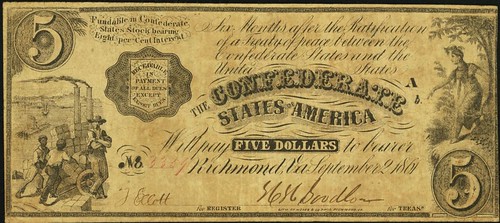
An Exemplary "Indian Princess" Note
Confederate States of America - T35 1861 $5 PF-1, Cr. 271. PCGS Very Fine 25.
Over the many decades that Eric P. Newman has actively collected and studied paper money, countless numismatic events and shows have been held. At those gatherings, perhaps the two most memorable paper money words uttered were "Indian Princess." This classic American currency note has maintained its lofty stature for well over a century. In 1883, John Haseltine declared in the sale featuring Harold's Newlin's Montgomery (or "first issue") notes that the "Indian Princess" was the rarest in the Confederate series. Like the "Grand Watermelon" in the Federal series, its deserving nickname and rarity make it a natural subject for all numismatists to discuss.
The layout and plate were developed from the Bank of Charleston $5 plate originally engraved by Draper, Toppan, Longacre & Co. that was sent to Hoyer & Ludwig. They used the "Princess" at the right, and counters, but developed the rest of the plate using other elements. At the lower left, young men, one with a wary expression, transport bales of cotton. They are overseen by a smoking man with arms crossed wearing a wide-brimmed hat (George Tremmel published a study of plate diagnostics, including the hat). A Native American princess on a high point looks off into the distance.
The titles and obligations are crowded into the right center with multiple arced flourishes over the block with white outlined FIVE DOLLARS and under the title. Below the princess and above the wharf scene are "5" dies. An additional obligation die with shield upon it is left of the titles. Plate Ab., serial number 3359.
To read the complete lot description, see:
Confederate States of America - T35 1861 $5 PF-1, Cr. 271.
(http://currency.ha.com/itm/confederate-notes/confederate-states-of-america-t35-1861-5-pf-1-cr-271-pcgs-very-fine-25/a/3539-18787.s?ic4=ListView-ShortDescription-071515)
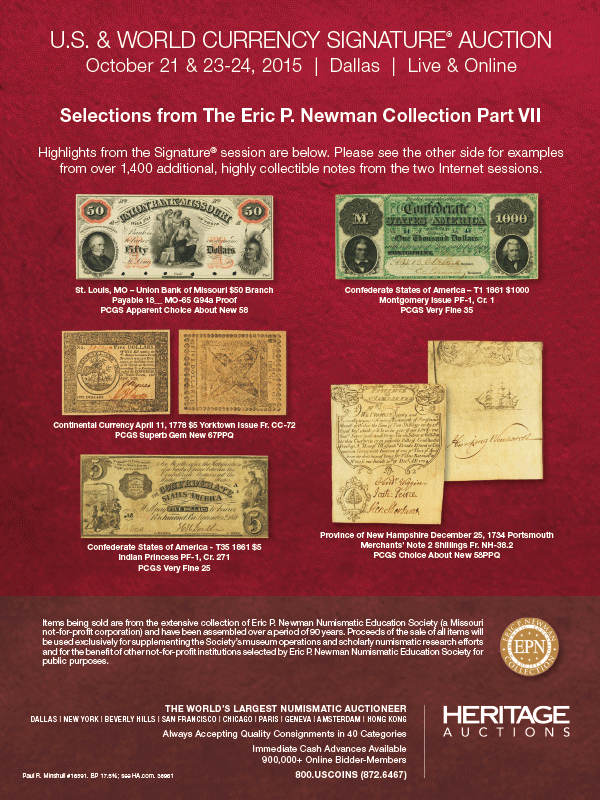
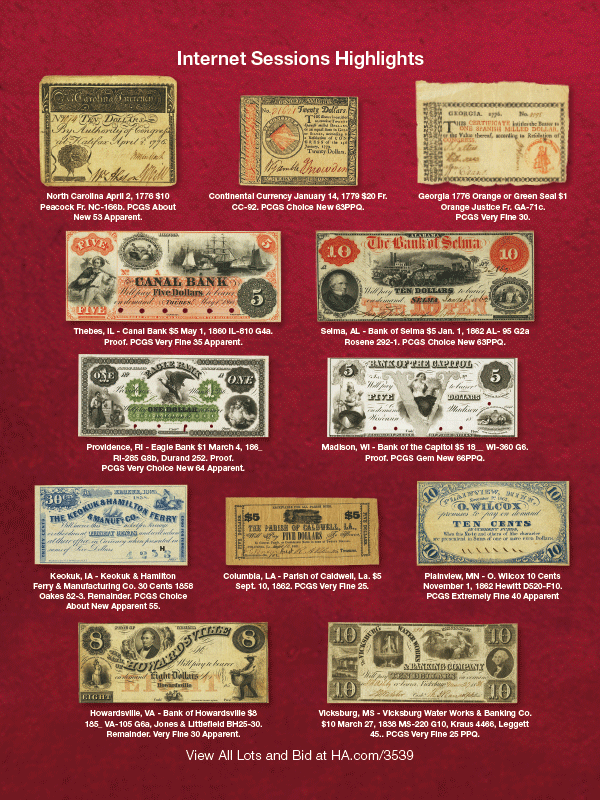
QUERY: MOMBASA MYSTERY COIN
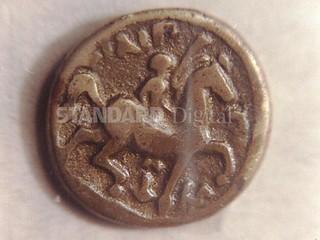 In 1993, a mysterious old coin was found in Likoni, Mombasa, near the former summer palace of the Sultan of Zanzibar, overlooking Kilindini
Port. The coin was copper in colour and had an image of a horse rider on both sides. It had thick edges and was about the same size as current Kenya
one shilling coin.
In 1993, a mysterious old coin was found in Likoni, Mombasa, near the former summer palace of the Sultan of Zanzibar, overlooking Kilindini
Port. The coin was copper in colour and had an image of a horse rider on both sides. It had thick edges and was about the same size as current Kenya
one shilling coin.
The coin was submit to Fort Jesus Museum to try and establish its origin and history. The Fort Jesus Museum carried out some tests on the coin and the Conservation Officer, Mr. Wazwa Mwadime, made a report on 24th February, 1994.(Ref. no. PUB.4/FJM/Vol.III/2)
Mr. Mwadime concluded that the coin was a form of Pendant or medal, in that the predominant design legend features a horse and does not feature a definitive observe and reverse side. He noted while coins are traditionally struck with the obverse and reverse aligned at a rotation of 180 degrees from each other (the head and tail sides are always upright if you turn the coin).
But the mystery “coin” was struck with the obverse and reverse aligned at a rotation of Zero or 360 degrees from each other (the reverse side is always upside when the “coin” is held upright and then turned). This alignment suggests that it was produced as a medal.
Mr. Mwadime concluded that due to its irregular size, it might be an off-metal strike for the purpose of presentation or sale to collectors. It might also have been a trial strike i.e. a first medal or impression produced from a new set of dices, hence the use of soft metal-copper. Fort Jesus Museum could not confirm the origin of the “coin” or its age but the fact that it was found near the former Sultan of Zanzibar’s palace in Likoni may give a clue that may have come from Zanzibar or Oman, the original home of the Sultan.
The oldest coins found in Kenya are about 600 years old and were found in Lamu in 2013 and were brought by Chinese traders who visited Lamu around 1400.
Could this “coin” or medal be the oldest found in Kenya?
To read the complete article, see:
Mombasa
Mystery coin could be the oldest ever found in Kenya
(www.standardmedia.co.ke/lifestyle/article/2000178338/mombasa-mystery-coin-could-be-the-oldest-ever-found-in-kenya)
THE ARMENIAN NUMISMATIC AND ANTIQUITIES SOCIETY
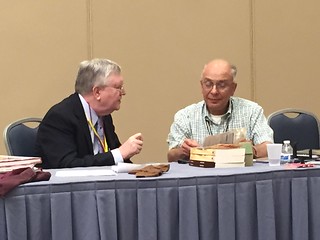 A new organization, the Armenian Numismatics and Antiquities Society (ANAS) was launched in August on the sidelines of the American
Numismatics Association’s World’s Fair of Money in Chicago. This first gathering of the society included a public talk by renowned numismatic experts
Dr. Levon Saryan and Frank Kovacs.
A new organization, the Armenian Numismatics and Antiquities Society (ANAS) was launched in August on the sidelines of the American
Numismatics Association’s World’s Fair of Money in Chicago. This first gathering of the society included a public talk by renowned numismatic experts
Dr. Levon Saryan and Frank Kovacs.
The fledgling organization has a website and plans to publish a quarterly journal. Dr. Saryan is vice president and journal editor and Dr. Chuck Hajinian is president of the group.
The goal of ANAS is to unite Armenians worldwide in their quest for knowledge about Armenian coins and related items and to provide a forum for them to share their collections, post items for sale, and exchange ideas. The website is intended to be a place where anyone can find interesting items relating to Armenian history. In short, a “virtual museum” available to anyone in the world.
The website is a work in progress with pages set up for books, carpets, coins, embroidery, manuscripts, medals, and other forms of art. The initial focus has been on coins and numismatics, with plans to grow in the near future. The Los Angeles-based Armenian Numismatic Society operated successfully for more than 40 years but for various reasons its activity has diminished, which has created a void.
“We hope to keep the voice of Armenian numismatics alive and well,” says Hajinian. “We have a great love of everything Armenian, especially antique items. The reason is simple: for 1,000 years many of our families lived in western Armenia. All of their belongings--coins, ceramics, manuscripts, jewelry--were lost and stolen during the Genocide. This is our way of recapturing and honoring the lives they lived and preserving these items for future generations. We want to shine the brightest spotlight we can for all Armenians to see their history and to appreciate the artistic work that their ancestors created.”
“We have coins and artifacts all the way from prehistoric times to the present--these need to be presented to the world and to our own people. Despite the efforts of many people, most Armenians have only the vaguest notion of the heritage embodied in these items,” adds Hajinian.
“You can explore 3,000 years of Armenian culture in coinage alone. We want to bring this from the back rooms of museums, closets, drawers, and put it on the web for everyone.”
To read the complete article, see:
Armenian Numismatic and Antiquities Society Launched in Chicago
(http://coinsweekly.com/en/News/4?&id=3650)
WHAT PROMPTS PEOPLE TO BECOME COLLECTORS?
Greg Cohen of Stack's Bowers Galleries and Stack's Bowers and Ponterio writes:
While not numismatic in subject, this is an interesting article on why we collect.
Like many rabbis, Grandpa amassed a vast collection of Jewish books, including rare folios and classical texts. Sixteenth-century Bibles, illuminated haggadahs, and anthologies of Yiddish poems stood among the bound volumes on shelf after shelf in his modest house, which he purchased in Brooklyn after he emigrated from Russia. Simply acquiring a treasure-trove of books, however, was too conventional to satisfy his eclectic tastes. He also cherished another object. Grandpa was an avid collector of etrogs.
Along with palm, myrtle, and willow, the etrog—known also as citron—is one of the four plant species required for rituals on the agricultural holiday of Sukkot. The citron looks like a large elongated lemon, but it never decays. Instead, it desiccates and shrinks over time without rotting. An unblemished, perfectly oblong citron can fetch hundreds of dollars, making it easy to envision the etrog as a precious collectible.
Grandpa’s etrog collection was not preserved by the family member to whom it was bequeathed. Still, it continues to be a source of reverie for me. I can’t help but wonder how he might have displayed his prized possessions for colleagues and friends. Would he have arranged them by color, the darkest brown fruit on the left with the newest etrog, still boasting a yellow hue, on the right? Or might he have cataloged them as a function of tactile criteria, from bumpy texture to smooth? I envision him positioning the etrogs in descending size order like the Russian nesting dolls he might have seen during his childhood. In my fantasy, I imagine him doting over his etrogs with the pride I’d like to think he’d have felt for my siblings and me, if he had been able to get to know us.
What prompts people to become collectors? Obviously, some are simply fascinated by a particular object. Others establish collections for the sake of society, as a form of civic altruism. Indeed, many great collections housed in museums of art or science reflect a public service rather than a personal proclivity.
Conversely, some Freudian psychologists see dark sides to collecting. For instance, when collecting is a quest, it often represents a lifelong pursuit that can never be fulfilled and instead becomes a catalyst for frustration. Moreover, there are situations when collecting reflects a need to hoard rather than have, so that collecting becomes a form of greed. But in piecing together Grandpa’s story from surviving relatives who knew him, I think that his collection was more likely an antidote to avarice.
At the conclusion of Sukkot four years ago, just prior to my first grandson’s birth, I did not discard my etrog. Instead, overcome by a sense of responsibility to my offspring, I resolved to save my etrogs from year to year, as my grandfather had done.
Grandpa and his etrog collection are no longer with us, but their respective legacies have not vanished. In selecting the etrog as an item for collection, Grandpa may have been sending a scholarly signal to his descendants to respect each other as the family tree arborizes with time. Collecting is not only about tangible objects, but also intangible values and ideas.
To read the complete article, see:
MY GRANDFATHER COLLECTED ETROGS—TO BE PASSED DOWN TO
FUTURE GENERATIONS (www.tabletmag.com/jewish-life-and-religion/143083/etrog-collector)
THE BOOK BAZARRE
THE CLIVE DEVENISH MECHANICAL BANK COLLECTION
One of the best kept secrets in the Mechanical Bank Collectors of America club is the Clive Devenish Bank Collection, which will have its initial public offering this October 3, 2015. Having been a dealer for over 40 years, Clive managed to quietly buy banks from some of the greatest collections assembled throughout the years, such as Stanley Sax, Leon Cometto, and more recently Steven Steckbeck. Clive's expert eye for quality, color, and beauty has amassed a collection worthy of bows of approval from collectors of all levels
TRICK DOG SIX-PART MECHANICAL BANK
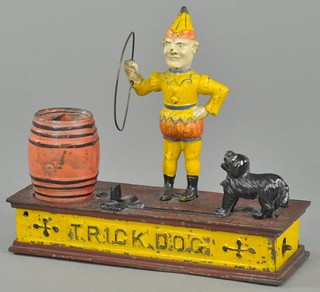
Hubley, Lancaster PA, cast iron, c. 1910 Yellow clown and base, red barrel, amusing action, the coin is placed in the dog’s mouth, and by touching the lever the dog jumps through the hoop and deposits the coin in the barrel, a popular seller for the company.
JONAH & THE WHALE MECHANICAL BANK
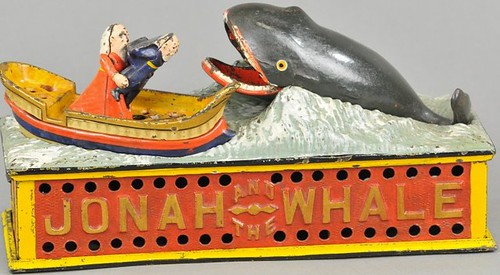
Shephard Hardware Co., New York , cast iron, circa 1890 Based on the biblical story , one of the most fascinating visually appealing of banks, exceptional mold designing, the waves appear as if moving, this is one of the finest examples ever offered here, colors are astounding. Place coin on Jonah’s head and press the lever; the man tosses Jonah forward and the whale opens his mouth. The coin slides off Jonah’s head and into the whale’s mouth, releasing the lever causes the whale’s mouth to move in an up and down motion that lasts for several seconds.
INITIATING SECOND DEGREE MECHANICAL BANK
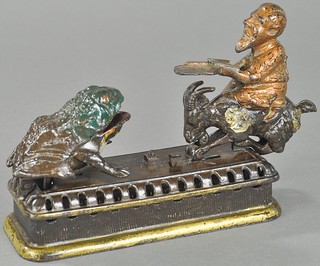
Mechanical Novelty Works, New Britain CT, cast iron, patented 1880 Also known as “Goat, Frog and the Old Man,” an amusing casting initially named the greedy frog, quite unusual imagery with intense details, very well designed and quite rare. Place coin on man’s plate then lift goat’s tail, goat springs forward causing man to deposit coin into frog’s mouth.
PUNCH & JUDY MECHANICAL BANK
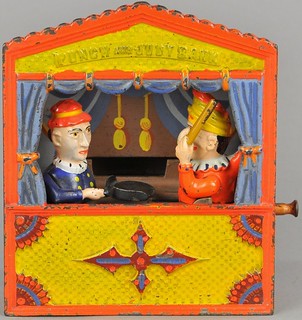
Shephard Hardware Co., New York, cast iron, patented 1884 Probably the most famous of puppet theaters, this example is vibrant and the action epitomizes the best in mechanical bank ingenuity, a real masterpiece in casting form, Punch and Judy figures are in exceptional condition. Pull lever to lock into position, place coin on Judy’s tray and press lever, action involves her turning in to deposit the coin as Punch attempts to swing at her with club in hand.
To view the complete sale online, see:
The Clive Devenish 40-Year Bank
Collection I (www.liveauctioneers.com/catalog/76842_the-clive-devenish-40-year-bank-collection-i/)
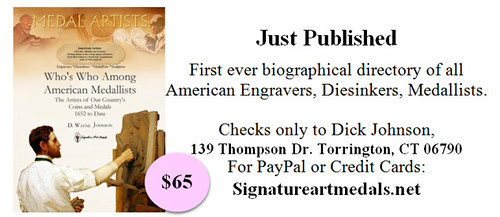
FEATURED WEB SITE: LIBERTY SEATED COLLECTORS CLUB
This week's Featured Web Site is the newly update site of the Liberty Seated Collectors Club.During early September, our club implemented a complete redesign of the www.LSCCweb.org website. Education Director, John Frost, spent weeks research-ing options and formats that culminated in a substantial upgrade to the LSCC information portal. The redesign website features drop down menus and mouse hovering information access. These improvements simplify locating membership information, regional meeting news, multiple LSCC information links on recent meeting presentations and videos, contemporary counterfeit databases, and club awards.

www.lsccweb.org
